Growth Strategy – Workshop 1 (Why Grow?)
The Appleton Greene Corporate Training Program (CTP) for Growth Strategy is provided by Mr. Ardila Certified Learning Provider (CLP). Program Specifications: Monthly cost USD$2,500.00; Monthly Workshops 6 hours; Monthly Support 4 hours; Program Duration 27 months; Program orders subject to ongoing availability.
If you would like to view the Client Information Hub (CIH) for this program, please Click Here
Learning Provider Profile
Mr Ardila is the co-founder of The Hawksbill Group, a business consulting and investment firm advising medium and large clients in the public and private sectors. Mr. Ardila is also a member of the Board of Directors of Accenture, Goldman Sachs BDCs, Nexa Resources and Ola Electric Mobility. Prior to his current activities, he was Executive Vice President of General Motors and CEO of Latin America from 2010-2016 (March). In his 30-year career with GM, he held several important positions, including country CEO in Ecuador, Colombia, Argentina and Brazil, as well as CFO of Latin America, Africa and the Middle East. He also worked as an investment banker for the Rothschild Group from 1996-1998 and Secretary General at the Ministry of Industry and Trade in Colombia (1983-84).
Mr. Ardila is a graduate of the London School of Economics where he obtained a MSc. Degree in Economics. He has lived in 10 countries and speaks English, Spanish, Portuguese and German.
MOST Analysis
Mission Statement
The long-term survival of a corporation depends on growth. It facilitates asset acquisition, talent attraction, and investment financing. Profit and corporate performance are also fueled by it. For a variety of reasons, corporate growth can be beneficial. For instance, it might enable you to seize fresh chances, broaden your offerings, draw in more clients, boost sales, and hire additional personnel. Additionally, it might assist you in meeting consumer demand, boosting your market share, and leveraging your expanding brand. It frequently encourages creativity, assisting you in standing out in the market and fending off competition. Growth can also improve your company’s reputation, give you more options for suppliers, and boost stability and revenue. But for growth to be effective and long-lasting, it must be deliberate and motivated by the appropriate factors. The majority of firms expand in order to grow larger, possibly by growing revenue or market share, but size isn’t the sole factor. Numerous more advantages spur firm expansion. For instance: More market sustainability or resilience, lower costs as a result of economies of scale, greater market dominance, greater purchasing and negotiating power, the capacity to mitigate commercial risks, such as through diversification, the capacity to lessen the threat of competition, the capacity to withstand market fluctuations and downturns, and the capacity to draw in the best talent and employees. For certain firms, growth may not be practicable or feasible, but in most circumstances, stagnation is more likely to result in missed opportunities.
Objectives
01. Survival: departmental SWOT analysis; strategy research & development. Time Allocated: 1 Month
02. Increase Sales: departmental SWOT analysis; strategy research & development. Time Allocated: 1 Month
03. Increase Market Share: departmental SWOT analysis; strategy research & development. Time Allocated: 1 Month
04. Greater Power to Control the Market: departmental SWOT analysis; strategy research & development. Time Allocated: 1 Month
05. Increase Profits: departmental SWOT analysis; strategy research & development. Time Allocated: 1 Month
06. Economies of Scale: departmental SWOT analysis; strategy research & development. Time Allocated: 1 Month
07. Protection from Risk of Takeover: departmental SWOT analysis; strategy research & development. 1 Month
08. Share Risk through Diversification: departmental SWOT analysis; strategy research & development. Time Allocated: 1 Month
09. Attract Customers: departmental SWOT analysis; strategy research & development. Time Allocated: 1 Month
10. Expand Products & Services: departmental SWOT analysis; strategy research & development. Time Allocated: 1 Month
11. Attract Top Talent: departmental SWOT analysis; strategy research & development. Time Allocated: 1 Month
12. Greater Sustainability: departmental SWOT analysis; strategy research & development. Time Allocated: 1 Month
Strategies
01. Survival: Each individual department head to undertake departmental SWOT analysis; strategy research & development.
02. Increase Sales: Each individual department head to undertake departmental SWOT analysis; strategy research & development.
03. Increase Market Share: Each individual department head to undertake departmental SWOT analysis; strategy research & development.
04. Greater Power to Control the Market: Each individual department head to undertake departmental SWOT analysis; strategy research & development.
05. Increase Profits: Each individual department head to undertake departmental SWOT analysis; strategy research & development.
06. Economies of Scale: Each individual department head to undertake departmental SWOT analysis; strategy research & development.
07. Protection from the Risk of Takeover: Each individual department head to undertake departmental SWOT analysis; strategy research & development.
08. Share Risk through Diversification: Each individual department head to undertake departmental SWOT analysis; strategy research & development.
09. Attract Customers: Each individual department head to undertake departmental SWOT analysis; strategy research & development.
10. Expand Products & Services: Each individual department head to undertake departmental SWOT analysis; strategy research & development.
11. Attract Top Talent: Each individual department head to undertake departmental SWOT analysis; strategy research & development.
12. Greater Sustainability: Each individual department head to undertake departmental SWOT analysis; strategy research & development.
Tasks
01. Create a task on your calendar, to be completed within the next month, to analyze Survival.
02. Create a task on your calendar, to be completed within the next month, to analyze Increase Sales.
03. Create a task on your calendar, to be completed within the next month, to analyze Increase Market Share.
04. Create a task on your calendar, to be completed within the next month, to analyze Greater Power to Control the Market.
05. Create a task on your calendar, to be completed within the next month, to analyze Increase Profits.
06. Create a task on your calendar, to be completed within the next month, to analyze Economies of Scale.
07. Create a task on your calendar, to be completed within the next month, to analyze Protection from the Risk of Takeover.
08. Create a task on your calendar, to be completed within the next month, to analyze Share Risk through Diversification.
09. Create a task on your calendar, to be completed within the next month, to analyze Attract Customers.
10. Create a task on your calendar, to be completed within the next month, to analyze Expand Products & Services.
11. Create a task on your calendar, to be completed within the next month, to analyze Attract Top Talent.
12. Create a task on your calendar, to be completed within the next month, to analyze Greater Sustainability.
Introduction
Why Growth Is Important For Business
A company’s ability to grow can help it surpass its rivals and seize the lead in the market. To keep the business successful and open for business, expansion must be carefully managed.
For businesses to expand and be prosperous, growth is essential. If properly handled, business development offers several benefits. These could include more revenues, a wider customer base, which might give the business more stability since they are not dependent on just a few clients, and cost savings. Growth brings economies of scale, and because a company is buying in larger quantities, it may be able to do it more affordably.
Diversification in terms of markets, goods, or services may happen with expansion, and this can be advantageous for businesses.
Growth can enable a company to overtake its competition and become the dominant player in the market. However, it is crucial that growth is managed and carried out at a rate that allows the company to continue to be profitable and to operate successfully.
Control over your company’s growth is ensured with a solid plan.
Before making any decisions that can negatively affect the company, business growth must be considered. Controlling growth is necessary to prevent a company’s expansion expenditures from exceeding its revenue, which would leave it unable to pay its creditors.
It is crucial to properly plan expansion from the beginning since business owners who do not comprehend the components of a strategy that appropriately matches their strategy to their business goals are likely to fail. In order to ensure a business’s growth proceeds as smoothly as possible, it is crucial to resort to certain tried-and-true business planning techniques.
How to organize your business’s expansion plan.
The adage “begin with the goal in mind” by Stephen Covey sums up what every business owner should take into account when formulating their strategy. You should think about your business’s purpose—that is, why you are doing it, what it means to you, and where you want to take it.
By offering a future road map—a corporate strategy—planning business milestones will assist in making any exit plan and goal a reality.
Consider a time frame of, say, five years and consider broadly where you want your company to go at that point. After that, think about where you want to be in three years, two years, six months, and right now. You’ll probably need to grow if you want to get from where you are today to where you want to be in five years.
Your sales objectives must be pertinent to your business’s long-term objectives and realistically attainable. The ideal approach is to continuously assess the operations’ relevance in the context of the external business environment and, when necessary, modify the plan. Business expansion can take place in a variety of areas. For example, consider how you might expand your business in terms of personnel, finances, location, diversification, new markets, etc.

What is the goal of your business?
Think about your company’s overall goal and how well the current organizational structure supports it. Which areas assist the company purpose and which areas don’t? How might this be made better? Create a framework that supports your final objective and document it! Establish goals and benchmarks for each division of the company in relation to the overarching goal. Put safeguards in place that will allow you to monitor your progress toward whatever goals you may have established.
How can your company expand?
There are various strategies for business expansion. You may expand it naturally using the resources already available to the company by boosting sales, adding new clients, product lines, a new region, additional sales channels, and generating more volume through larger markets and clients.
The company may decide to take on a loan, business grant, asset finance, crowdsourcing, or any of the countless other options that may be considered to assist the expansion of the business if other methods of expanding the business require outside support. This entails some risk, which must constantly be taken into account and weighed against your long-term business objectives.
Always keep an eye on the budget, take a look at the projections, and consider the cash flow. This is crucial now that we have been cohabiting with Covid for a while. It’s crucial to take business risk and opportunity into account. It’s also crucial to be able to react swiftly to any changes in circumstances and keep an eye on this. Do not exceed your capacity; instead, plan ahead.
What skills are required to expand your business?
For a company, growth can be both a difficulty and a source of great excitement. New skill requirements may arise as a result of business expansion, such as when you hire your first employee. It will be crucial to take competition into account, which you might not have done before. Competitors will notice and keep an eye on you as you effectively expand, therefore you must also do this. It will be crucial to make sure you have the fresh skill sets needed for development.
Success in expansion is accompanied by confidence. Growth is challenging, though, so it’s crucial to remember to prioritize your needs and create time for yourself when you take on new responsibilities. Don’t undervalue the fresh difficulties!
What advantages does expanding your business offer?
A certain amount of risk comes with expanding your target market, products, activities, or location, but if your competitors are changing, it could be necessary for you to as well. When planning to expand the business, lifecycle and market demand should be taken into account.
Gaining growth can have significant advantages. Both the possibility to enter new markets and the opportunity for distinction exist. You will be distributing your risk, but you must constantly weigh this against the associated costs and take into account how expanding into new markets with a new product may influence your brand identification. Depending on the industry you are in, brand identity may become stronger through expansion through innovation.

How can effective business expansion be ensured?
If expansion is successfully controlled, stability may follow, giving the business owner additional peace of mind. As the business develops and grows, it may also be perceived in the marketplace as a corporation that is succeeding as it grows.
But in this case, a word of warning is necessary. The need of controlled, planned, and well-managed expansion is crucial because the appearance may not always correspond to reality. Not stretching the firm too thin to the point that it overtrades, which is why it’s crucial to keep an eye on the impact on the finances at every stage of growth.
controlling risk
Growth can spread your risk and lessen your reliance on a single market or consumer. If properly handled, your profits will rise. Better talent is attracted by successful businesses. However, throughout the growing phase, vigilance must always be used. It’s important to keep an eye on possibilities and risks as you grow to prevent any quality lapses. This must be kept in mind since as a business owner, as you expand, you can lose the strict, hands-on control you originally had over every aspect of your firm.
financial preparation
Above all, as you advance, sound financial planning is still essential. Accept the chance to expand, but also make sure you know why you are doing so. Wherever you can, try to limit risk and promote stability rather than welcoming in too many hazards. Know your industry, your customers, and any upcoming dangers and opportunities at all times. To expand your business successfully, you must plan and monitor every aspect of it, and you must also be able to act swiftly when an unexpected shift occurs.

Why growth is important even to just sustain the business
The popular saying for any business model goes – “if you’re not growing you’re dying”, so whether you like it or not, businesses cannot afford to stop still. As a company grows beyond the startup stage, the focus must shift, especially for small enterprises. For long-term success, discovering chances for corporate growth must take center stage. However, few businesses are aware that accomplishing the company’s goals requires a determined strategy and that growth is illusive.
Growth is thought to be illusive by scientists for two main reasons:
“Inadequate consideration of opportunities within the core business, adjacent to the core business or within new customer sub-segments.
An organizational infrastructure that cannot support successful execution”
Growth, in fact, represents a different thing to different people/businesses. For many businesses, growth is something that grows you, your employees, and team and grows an organization as a whole. It adds value to the company, which is much more fulfilling than just the financial aspect. Growth and profitability are the two most crucial elements a company should take into consideration to be successful and stay in business and to continue to be appealing to investors and analysts. When there is no organizational growth, your business may have a number of negative effects:
• There won’t be any growth in earnings and profits
• There won’t be any hike in employee’s income
• There won’t be any potential for additional jobs openings
• Reliable employees might leave your organization soon
• You will limit options to innovate new products and services
• Your business rivals will grow
• Business could stagnant and lose out on lucrative opportunities
• There could be a greater drop in the productivity factor.
• Existing infrastructure fails to support additional complexity if any.
• Your unique selling point might not impress your customer anymore
• Your industry ideas will develop, but you will be left behind
Having said that, any company’s long-term viability still depends on growth. Additionally, increasing sales and the market are ways to make a quick profit. And the stage of business growth is when your company reaches the point of expansion and looks for new opportunities to generate more revenue. In a broader sense, growth is the most crucial element in the development of industries, businesses, and sustainability.
But it’s not easy to take a firm from an initial concept to sustained success. Many people make mistakes and expand too quickly, increasing the risk of resource depletion and inability to satisfy consumer demand. Even though there isn’t a universal formula for calculating optimal growth, it’s still crucial to plan your growth so that it may be managed and controlled.

Let’s examine why a business must expand in order to survive:
Growth is required for Sustainability – To continue existing in a certain sector for a longer period of time is to sustain oneself. A firm must be sustainable in order to expand, and it cannot grow without being sustainable. The business environment is constantly changing, thus it is best for a company to adapt to this change and seize opportunities to ensure its sustainability.
Credibility is built via growth – When a company persists in its field for an extended length of time, the market starts to take notice. Additionally, a company with a positive reputation and goodwill is more likely to draw in new patrons, workers, and investors. The level of trust and confidence that people have in your company can have a significant impact on the main goal of the business.
Growth reduces competition – Competition was once thought of as a motivating force for improving goods and services. But lately, competition has increased, and businesses are trying to stay away from it. Growing continuously makes it easier for a company to compete successfully on all fronts. Growth creates space for development and diversification, which ultimately aid in fending off fierce competition.
Growth lowers commercial risks, which are possible losses brought on by customers or other businesses – Any organization’s product development team has a duty to minimize risk, both technical and commercial, after the product is released for sale. Reduced risk of sliding off the cliff is now a simple chore for a well-managed and sustainable firm.
Innovation fosters growth – A company must successfully implement new ideas if it is to advance and grow. Innovation introduces new goods and services, boosts productivity, and drives profitability. Innovation has enormous advantages for both customers and businesses, and a company can only consider innovation if it is expanding sustainably. In the alternative, a company that isn’t innovating would lose market share to rivals and fall short of productivity and efficiency.
Partnerships and joint ventures are reaped by growth – When a firm is expanding, it frequently arranges for alliances, joint ventures, mergers, and acquisitions. More contacts, higher market shares, lesser business risks, a larger client base, favorable financing alternatives, more resources, and a chance to enter a new market are all obvious advantages of this dimension.
Growth retains customers – Emmet and Mark Murphy write in their book “Leading on the Edge of Chaos” that obtaining new clients can cost a business around five times as much as keeping old ones. In fact, a 2% increase in client retention can have the same effect as a 10% cut in cost for a business. Instead of seeking for new clients and persuading them to do business with you, stable growth helps to maintain existing consumers, who are actually your best option for expanding sales.
Profitability is impacted by growth – Although growth is not restricted to profit, it does aid in achieving and sustaining profitability. Even in organizations with strong financial performance, there should always be room for expansion because this presents chances for increased overall profitability and sustainability in line with the needs of customers, analysts, and future or existing investors. Profit and growth go hand in hand with business success; if profit is necessary for managing financial survival, growth is essential for profit and long-term success.
Businesses that want to put growth first need to properly prepare their growth strategy. While there are hazards associated with growth, the appropriate plan can provide stability, security, and long-term success. In order to simply survive the business and sustain it well once you have past the start-up stage, start setting growth goals, involving management, controlling costs, and frequently reviewing targets!

There are several strategies to expand your company, each of which is better suited to a particular sort of company, market, sector, product, or service.
– Organic growth.
Organic business expansion takes time and is typically safer and more stable than development through acquisition. Making your present business model more effective while reducing costs and expansion is the goal of the organic growth strategy. Organic expansion may involve selling:
• to new customers
• a new line to your existing customers
• in new geographical areas
• via additional sales channels
• a greater volume to bigger markets/customers
To expand your company’s offering, it may also include hiring new people or retraining your current staff.
These growth strategies typically involve less inherent risk and complexity and are more predictable. For instance, you might need to increase your current sales team or simply start a new marketing campaign in order to advertise your current product line to new clients or geographical areas.
– Acquisition.
A quicker, albeit riskier, approach to expand your company is by purchasing another one. The company you buy can be a rival of yours or it might be a company that enhances what you already have to offer. A easy strategy to quadruple your revenue is to buy a company with a similar turnover to your own.
– Joint Venture.
A solid and mutually advantageous approach to expand your customer base, penetrate new markets, and acquire additional talent with local/product knowledge is by joining a joint venture. Joint venture partners typically offer services that are mutually beneficial and can advance both businesses.
– Franchising and Licensing.
If your brand is well-known and has sufficient equity, licensing out your good or service can be the solution. By allowing licensees to sell your product, you can earn money from their sales with little initial setup expense. And it might open up new domestic and international markets for your brand.
The concept of licensing is presented in a somewhat different light through franchising. This is ideal for firms needing less control on auxiliary operations because it requires less upfront investment and could generate large revenues from committed franchisees.

Motives for expanding your business
There are numerous reasons why expanding your business can be the best course of action. The factors that apply to your company will determine the course of your growth. Therefore, it’s crucial to comprehend your motivations in their whole.
1. Satisfy consumer demand.
You’ve done a thorough analysis of the market and are confident that your product or service meets the demands of the present market. Your research has demonstrated that there is a sizable and concentrated demand for your product at the price you require to maintain your growth objectives.
In this case, growing into new markets and hiring more personnel will enable you to build on your current success. You can boost your market share and take advantage of your rising brand equity to maybe overtake the competition.
Due to a capacity shortage, you could currently need to decline jobs. This is just another compelling argument in favor of expanding your workforce.
Careful planning is necessary to effectively finance this kind of expansion in order to prevent unaffordable costs or overextended commercial capacity. To close gaps in cash flow that rapid development can cause, many firms rely on services like supplier payments loans.
2. New markets, rivalry, and innovation.
Because they do not give customers a compelling enough reason to transfer from their present supplier to the new commodity or service, many small businesses fail. The solution may lie in entering new markets if you’re having trouble with intense competition and a bland offering.
Your company can build a presence in areas where there is a specific need for your product or service by expanding into new markets. This can aid in minimizing the effects of market saturation and intense competition.
Moving to a larger facility or to other sites may boost your production capacity and aid in driving away competition if you’re wanting to stay in your current market.
Innovation is another aspect of growth. By making improvements to your product or service, you can set yourself apart from the competition and improve your prospects of enduring success.
Growing your firm aids in building a better brand identification, which further aids in fending off rivalry. You can grow your brand via franchising, granting licenses for your goods and services, or entering carefully curated new product categories. Your brand identity matures and your revenue rises as the number of stores and items rises.
3. Boost stability.
Businesses typically become more stable as they expand. A one-person company with few revenue streams is far less reliable than a company with several locations and dozens of employees.
This stability is also in part a result of how people view your company. People think you are more likely to stick around for the duration of their products’ lives to provide spare parts and uphold warranties as your business expands. You’ll probably sell more goods and services to this market segment if your business expands.
Your concentration risk from market fluctuations and downturns is also spread out by expanding your operations across many markets and regions. Increasing your supply base also helps.
4. Boost Profits.
If your company is bigger, you can benefit from economies of scale. Larger companies frequently qualify for bulk discounts and better supplier credit terms, which lower expenses and boost profitability.
A higher turnover can also indicate a higher chance of making money. A lot of expanding businesses see their earnings rise along with their operations thanks to the gains in profit margin that economies of scale can offer.
When margins are getting thinner or revenues are declining, expansion or investment is frequently made. Entering the export market may be one of the best ways to increase sales, and there is a wealth of information on government websites to assist.
5. People.
Finding the ideal employees to manage your company is essential but difficult for many business owners. The greatest talent tends to be drawn to growing organizations. A successful, expanding business offers its employees options and challenges, which makes them incredibly alluring. It can be energizing and professionally satisfying to be a member of a rising company.
Additionally, the company is no longer dependent on you once you start handing off managerial and operational choices to others in your organization. You can spend more time on personal interests as a result.

Why is business growth important: what happens when you do not grow
Growth means a lot of things to different people. Right now, I’m speaking to the kind of development that helps you, a team, and an organization grow. It develops a wealth that is much more fulfilling than money on its own. What happens then if you don’t grow?
1. If your profits don’t decline, they’ll remain roughly the same.
2. You will be unable to increase employee pay.
3. You won’t be able to provide your clients cutting-edge goods and services.
4. You won’t produce more jobs.
5. You won’t be able to give more to the families of those who work for your company.
6. You’ll lose excellent workers who want to advance.
7. You’ll face more competition.
8. It’s possible that you’ll fall behind in your field.
9. You can grow bored with the industry.
10. You’ll restrict your employees’ potential.
The list could go on and on.
Giving others the chance to develop and prosper is the finest motive to improve. You must expand if you want to provide your staff with greater opportunities. Therefore, business expansion is crucial.
Nothing stays the same. It either gets bigger or smaller. Better or worse. You either grow or you shrink.
Being a permanent small business is not a problem. Just consider the repercussions.
Don’t expand merely for the sake of expanding. Grow because of the chances and “wealth” you are producing for both you and other people.
Executive Summary
Chapter 1: Company Survival
Doesn’t every entrepreneur and/or business owner start and maintain a business in order to see it grow? The answer seems obvious. But as many top business coaches will tell you, some business leaders who attain a certain level of success are content to stay at this plateau. They feel assured within the space their business occupies in the marketplace and have little motivation to change anything.
This is a risky stance for any business leader to take. Growth isn’t just important for a company—it’s absolutely essential. Without continued growth, operations will stagnate and your business’ survival will be at risk. This can result in lowered standards of quality for products or services, decreased customer service, poor employee morale, and a host of other issues.
Growth is crucial to the long-term survival of a business, as well as having several other benefits:
• Easier to add resources
• Locate and identify new sales opportunities
• Expand range of products or services
• Acquire new customers
Also, growth can “boost your business’ credibility, allowing you to broaden your supply base and increase stability and profits.”
Plenty of other reasons spur business leaders to adopt a “continuous growth” mindset. A growing, financially secure company often enjoys market dominance (meaning, less threat from competitors), which in turn brings enhanced power to negotiate large-scale purchases (new technology, for example) and/or more beneficial lease or rent arrangements.
Effective growth also helps stave off the potentially negative effects of fluctuations in the marketplace and national economy. Plus, a growing company’s high profile often appeals to the most talented job-seekers out there.
Healthy growth boosts corporate survival rates, which was true in 2008 and remains true in the United States and in other developed markets. From 1983 to 2013, for instance, roughly 60 percent of the nonfinancial companies then in the S&P 500 were acquired—it’s grow or go, and they have gone. Consider these findings over that period:
Sixty of the 78 S&P 500 companies that generated top-line growth and improved or at least maintained their margins outperformed the S&P 500.
Companies with deteriorating margins performed less well, even if these companies were growing; just 8 out of 30 outperformed the index.
A higher percentage (56 percent) of companies that grew slowly, but also aggressively distributed cash to shareholders, outperformed the S&P 500.
The growth culture isn’t a component of a company’s strategy, it is the company’s strategy. Growth is a framework that needs to drive all operational tasks, projects and initiatives of a company. The DNA of the company needs to be growth. Opportunities for growth are endless and should always be seized. Companies that don’t grow generally don’t attract the most talented team members (because great people seek growth) and are therefore at a disadvantage from the very beginning.

Chapter 2: Increase Sales
Business growth occurs when your business is experiencing permanent increases in profit as a direct result of measurable and sustainable increases in “sales volume.” Only increases in sales volume that generate additional profit can be considered to represent real business growth. For example, your business may temporarily cut its prices, generating increased sales, in order to achieve a larger share of the existing market for your business’s products and/or services. But business growth will only have occurred when this increased market share leads to future sales that are profitable.
As the owner of a business that’s already successful, you should first identify your business’s growth (increased profits) to date, then determine what spurred this growth. Do this by determining which marketing efforts have historically made the greatest contribution to your business’s increased sales volume. Then you can exercise your first option for growing your business: continue implementing those successful marketing efforts.
Your second option is to consider new business growth strategies that can be expected to generate additional profitable sales, such as the following two important strategies: selling more to your existing customers, and selling to new potential customers.
Selling more to your existing customers, called an “upsell,” typically doesn’t just happen. In order to sell your customers more, you have to be prepared to actively market to them, and to do so continuously. Some strategies:
• Offer incentives, such as quantity discounts, to encourage multiple quantity purchases. An example would be to offer a “buy two, get a third free.”
• Bundle similar products and/or services with or without a discount-for example, a stereo receiver, a CD player and speakers.
• Offer complementary products and/or services that are natural companion purchases. For example, when a bank provides its customers with banking services and also offers securities brokerage.
• Add additional inventory as a way of encouraging additional sales of new products and/or services. The additional inventory can be funded by increasing your investment in your business or by offering another business’s products and/or services to your customers by way of a “strategic product alliance.” This alliance allows you to offer selected products and/or services of the other business, without having to invest in any additional inventory.
Selling to new prospects should be an ongoing effort to add new customers to your existing customer base. Some strategies:
• Share your customer base with another business. This strategy allows you to gain access to another business’s customers to whom you can market your business’s products and/or services. This is referred to as a marketing alliance.
• Target the existing customers of a competitor by making the competitor’s customers aware of your business, referred to as a “major sales advantage” (MSA). The MSA consists of such advantages as better-quality products, higher levels of service after the sale, a larger variety of inventory and/or services to choose from, or lower prices.
• Engage in “direct-response marketing.” This consists of the application of marketing strategies that are designed to cause the potential customer to “take immediate action,” such as coming into your store or picking up the telephone to call your business.
Whichever methods your business uses to achieve increased profits from measurable and sustainable increases in sales volume, it’s important that you identify “repeatable processes” that can be implemented again and again to provide the ongoing business growth you are seeking.

Chapter 3: Increase Market Share
A company’s market share is the percentage it controls of the total market for its products and services. Market share is an essential metric for businesses because it’s an indicator of a company’s profitability, success and represents growth. It can signal dominance in an industry and how well a company’s revenue-generating efforts are working to achieve business goals.
Market share can affect operations, pricing of products and services, and, potentially stock market performance. A growing market share corresponds to growing revenue. That, in turn, means a business can scale up its operations and opportunity for greater profitability. To gain market share should be a serious business goal.
There are a number of strategies a company can put to work to increase market share. These include improving innovation, building and solidifying customer loyalty, employing a talented, dedicated workforce, acquiring other companies, deploying effective advertising, and pricing products and services efficiently.
A higher market share places companies at a competitive advantage:
• Companies with high market share often receive better prices from suppliers, as their larger order volumes increase their buying power.
• Increased market share and greater production go hand-in-hand, with the latter providing a company with the opportunity to decrease the cost to produce an individual unit due to economies of scale.
• Higher market share can help improve sales when existing, brand-loyal customers buy more of a company’s products.
• Market share may also widen a company’s overall customer base as potential new customers follow the lead of existing ones.
• Gaining market share can strengthen and spotlight a company’s reputation. In addition to boosting sales and increasing bargaining power, that can attract new, more talented employees.

Chapter 4: Market Power
Market power refers to a company’s relative ability to manipulate the price of an item in the marketplace by manipulating the level of supply, demand or both.
A company with substantial market power has the ability to manipulate the market price and thereby control its profit margin, and possibly the ability to increase obstacles to potential new entrants into the market. Firms that have market power are often described as “price makers” because they can establish or adjust the marketplace price of an item without relinquishing market share.
What gives rise to Market Power?
Note that a market with perfect competition has no market power. This is because when the competition is perfect, the players will have zero power. Instead, each commercial enterprise will have to work with the current price in the market since it cannot be manipulated or changed. However, the perfect competitions concept is of the assumption that there is no even one producer who can determine a price for the overall market. For companies that produce the same products and services, they all vary in their market power levels. Generally, market power is only present where there is:
• Oligopoly: This is where there is complete domination of a market by either two or more than two suppliers.
• Monopoly: This is where a market is controlled by only one supplier.
• Monopsony: This is where a market is dominated by one buyer. A good example is the United States defense industry which represents over 85% of the purchases.

Chapter 5: Increase Profits
Expanding businesses and achieving higher sales is one of the ways of becoming more profitable.
As we know, business growth results from an increase in output which is goods produced and services provided. If this output is sold, then sales increase. Increased sales, when prices remain unchanged, will consequently increase sales revenue.
In order to also increase profits while expanding (increasing sales revenue), the business should keep its costs under control. Keeping the costs at the same level as before expansion, or keeping the growth of costs less than the growth in sales revenue, should also increase profits.
So, when businesses grow, their profits may increase as well.
Business Operations Expansion
Making a profit is essential for a business that desires to expand it operations. Earning a profit allows you to open other business locations, acquire another business, target other markets and expand your operations into foreign territory. The purpose of business expansion is to further increase your profits. Earning a profit is not the only factor that influences the decision of whether to expand your business, however.
When you are growing your business, your management and back office team should be able to take on additional responsibility. You should create a business plan for expansion and analyze trends and economic factors that affect your business.
Ability to Borrow Money
Many businesses depend on debt financing to operate. Debt financing obligates a business to repay the money borrowed to the creditor with interest. Debt financing for a small business typically includes borrowing money from a bank. A company’s profitability plays an important role in whether a bank lends the company money.
In addition to profit, a business owner’s credit score and collateral are determining factors in lending decisions. A company that cannot turn a profit is typically seen as a risk for default by a lender.
Attract Investors Financing
Some businesses choose to bring in private investors to secure funding for their operations. A company that earns continual profits is seen as a potentially good investment option because the investor believes there is a good chance to earn an attractive return on his investment. Attracting investors depends on your ability to show the monetary benefits of investing in your business. As a business owner, you should prepare to show potential investors your ability to generate profits in previous years and your plans to continue to earn profits in the future.
Hire More Employees
A part of growing a business includes hiring additional employees who can handle the growing responsibilities within the company. A business that is profitable has a better chance of affording to pay new employees’ salaries than a company that is struggling financially. Hiring new employees is an important element of running a business because employees are typically given more responsibility, especially in smaller companies. A business owner must allocate resources to defining open job positions, developing a hiring process and creating training programs.

Chapter 6: Economies of Scale
What are Economies of Scale?
Economies of scale refer to the cost advantage experienced by a firm when it increases its level of output. The advantage arises due to the inverse relationship between the per-unit fixed cost and the quantity produced. The greater the quantity of output produced, the lower the per-unit fixed cost.
Economies of scale also result in a fall in average variable costs (average non-fixed costs) with an increase in output. This is brought about by operational efficiencies and synergies as a result of an increase in the scale of production.
Economies of scale can be realized by a firm at any stage of the production process. In this case, production refers to the economic concept of production and involves all activities related to the commodity, not involving the final buyer.
Thus, a business can decide to implement economies of scale in its marketing division by hiring a large number of marketing professionals. A business can also adopt the same in its input sourcing division by moving from human labor to machine labor.
A firm’s efficiency is affected by its size. Large firms are often more efficient than small ones because they can gain from economies of scale, but firms can become too large and suffer from diseconomies of scale. As a firm expands its scale of operations, it is said to move into its long run. The benefits arising from expansion depend upon the effect of expansion on productive efficiency, which can be assessed by looking at changes in average costs at each stage of production.
The firm’s long run average cost shows what is happening to average cost when the firm expands, and is at a tangent to the series of short run average cost curves. Each short run average cost curve relates to a separate stage or phase of expansion. The reductions in cost associated with expansion are called economies of scale.
Advantages of economies of scale
The benefits of economies of scale to industries and businesses are wide-ranging, but generally speaking, it enables large corporations to reduce their costs, pass the savings onto the consumer, and gain an advantage over the competition. So, what are the advantages of economies of scale?
• Reduced long-term unit costs – One of the main benefits of internal economies of scale is reduced costs, enabling businesses to improve their price competitiveness in global markets.
• Increased profits – Economies of scale lead to increased profits, generating a higher return on capital investment and providing businesses with the platform to grow.
• Larger business scale – As a business grows in size, it solidifies and becomes less vulnerable to external threats, such as hostile takeover bids. This is one of the key benefits of economies of scale to industries as it has a positive effect on the company’s share price, as well as their ability to raise new financing.
Of course, there are also plenty of advantages of economies of scale for consumers, as lower unit costs often feed through to reduced prices. What are the advantages of economies of scale for consumers?
• Lower prices – Reduced cost-per-unit leads to lower prices for the consumer, meaning that overall, consumers will have higher real incomes and easier access to affordable products.
• Product improvements – Businesses can potentially reinvest their capital savings in research and development, leading to improved products (e.g. cheaper pharmaceuticals and food).
• Higher wages – For employees, another key benefit of economies of scale is the potential for profit sharing and higher real wages due to savings on cost.

Chapter 7: Protection from the risk of takeover
Public limited companies are often at risk of hostile takeovers – buying a majority stake in the business, because they have growth potential, have a widely recognized corporate name or due to a decrease in profits and subsequent fall in their share price.
But, large businesses are very, very expensive to be taken over – just look at the market capitalization of Apple (USD$2.29 trillion) or Microsoft (USD$2.05 trillion). Therefore, there is less risk of being a takeover target because simply there are not that many investors who can afford to buy such a large company. So, the larger the company, the more difficult it is for others to take it over because at least 51% of the company’s shares must be bought. Buying more than 50% of shares of Apple or Microsoft will cost around 1 trillion dollars each. Currently, the richest man in the world Elon Musk, the CEO and co-founder of Tesla, has an estimated net worth of USD$177 billion.
Sometimes though, the takeover is welcomed by the company’s directors and shareholders as they may want to sell their shares for cash and retire.
Takeovers are common practice—disguised to look like friendly mergers. It could be a mutual agreement or a hostile battle. In a hostile takeover, the acquirer secretly buys the shares of non-controlling shareholders from the open market. Gradually the acquirer takes hold of more than 50% of the target’s stocks, gaining control. The target firm management and board are unaware of such developments.
Takeover Explained
Takeover deals can be paid in cash, stocks, or both depending on the mutual agreement of parties. Mergers, acquisitions, and subsidiaries are the most common strategies followed. What motivates buyouts? At times, the acquirer may see an immense scope of growth and long-term value in a target firm. Sometimes, the acquirer intends to enter a new market immediately and with little investment. Capturing a huge market share, acquiring valuable resources and assets, attaining economies of scale, and profit maximization are among other motives.
Moreover, a larger company may be willing to eliminate competition by buying a smaller company. In an activist buyout, the acquirer intends to gain a controlling stake and initiate changes. Sometimes the reason behind an acquisition can be as crazy as a great deal, where a target company is available for a steal.

Chapter 8: Shares Risk through Diversification
Diversifying into new markets rather than focusing only on one specific market, as well as creating new products rather than just focusing only on one product, will help the business to grow.
Also, if there are any dramatic negative changes in that particular market, then having business operations in other markets will help not only to maintain growth, but also safeguard the firm’s survival.
Businesses are the backbone of the economy and at this time, against this ever-changing landscape it is important for industry to re-evaluate strategic direction and operations, in particular risk management, competitiveness, and sustainability and growth.
As a business strategy, international markets not only allow for business growth, but create new capabilities for the organization; in terms of adaptability and the understanding of international trade practicalities. This in itself will build resilience into the business models as cash flows, productivity and supply chains will all need to be to flexible and re-evaluated and restructured. Seeking international growth by going global offers opportunity and advantages and sound business reasoning. It is also a mechanism for positive risk management through identifying, assessing and managing potentially beneficial outcomes.
Through expanding business operations internationally, businesses spread their risk in a number of ways. Establishing new sales as the domestic market have reached or close to saturation allows for continued revenue to mitigate costs of production, but also eliminates negative organizational impact for example workforce reduction. This can be further extended by identifying new relevance and applications in new markets for existing products can extend the product life of lines that were perhaps considered as completed and no longer required. This then generates new sales for the product as it is, new applications and, possibly some innovation management for market- appropriate modifications.
New markets also reduce the dependence on the markets already developed – whether these are domestic or international. Existing exporters can look at additional international markets whereas new exporters can identify first-time exporter opportunities. This spreads risk by having multiple revenue sources as well as an increase in overall income. Furthermore, some business models are predicated around seasonal cycles that can potentially be extended to all year round through international growth. Business operations and production cycles can be realigned for those with seasonal demand cycles so that there is continual production, delivery and sales processes.
Going global can expand horizons in other areas that will lead to reduced risk and in the mid to long term increase business growth. Through knowledge transfer and know-how businesses can create new partnerships and collaboration for research and development of new products and services that can be applied in the global marketplace. Through partnering with an international counterpart at the outset there is a phenomenal opportunity to bring specific expertise and know-how together, establish wider networks and create new product and service solutions for application across a multitude of markets and sectors.
Alongside adaptability and growth, these all contribute to making the business stronger and more resilient as it moves to being a more robust organization with an increased level of security of business survival. This is paramount for SMEs who need to establish mechanisms to remain competitive with relevant and applicable solutions. The overriding reason to go global, of course, is to improve business potential for expansion and growth – there is always an opportunity to sell something, somewhere. Unearthing just the right opportunity involves more work, of course.
But going global is risky business so how can it help to spread and mitigate risk? Going international is all about preparation and due diligence. Going global requires planning and pertinent issues to be addressed in order to enter a global market place with success. These topics include understanding the market, market entry strategies, finances and payment terms, product / service compliance, packaging, labelling, culture, logistics, to name a few. What is absolutely paramount is in-depth market research which will allow for informed decision-making to enable the scaling-up process to be more linear. Once the market is understood in terms of opportunity it can be examined further for access and viability. Culture and language will play a part in the decision-making and this will influence your route into market. Maintain a focus – just because a number of countries show interest doesn’t mean you’re ready to sell your product everywhere. Patience is key. There needs to be a discipline in how business reacts to enquiries from a country which they know very little about.
With an economic emphasis on boosting exports, as well as technology and innovation, business support for planning strategy, examining opportunity, and ultimately spreading risk is of the utmost importance. By entering the international arena, business can protect themselves against the risk of decline in domestic markets and, most important, significantly improve overall growth potential.

Chapter 9: Expand Products or Services
Large brands are well-known for adding new products to their portfolios. The Coca-Cola Company started with one product and expanded its line to more than 500 brands worldwide, including Sprite, Fanta and Dasani. There are many reasons to expand a product line, most notably to grow your revenues and market share.
What Is Product Expansion?
There are several types of product line expansion:
• Adding new versions of existing products, such as when Coca Cola introduced Diet Coke and Cherry Coke
• Providing upgrades to existing products, which is what Apple does with each new version of the iPhone
• Adding new products to your portfolio. This could be as simple as adding red shirts to your current line of green shirts, or you could follow Apple’s example and sell accessories for the main product – in Apple’s case, a range of adapters, chargers and software applications for the iPhone
According to customer experience optimization company AB Tasty, the reason for product expansion is simple: No company can survive on a single product. There will always be competitors who can make that product cheaper, faster or better. Expanding the product line is one of the strongest ways to minimize this risk.
Boosts Market Share
The more products you have, the greater your chances of reaching a wider audience and purchasing market. Market expansion can help you get a firmer hold of your current market and open your business to a new audience.
For example, suppose you sell a line of swimwear on your e-commerce store. You have loyal customers who return to your store each summer, but they only buy one or two swimsuits a year. By expanding your offer with a line of summer clothing, sunglasses and sun hats, you not only sell more to your current customers, but you also attract new customers who want to buy summer clothes.
Increases Customer Loyalty
Unless you are selling products with a short shelf life, such as food, then at some point, your loyal customers are going to have enough of your product. Expanding your product line gives them fresh opportunities to engage with your brand.
This works on two levels. Selling more products obviously increases your revenue. More significantly, adding a new product line also decreases your overall costs because it’s much cheaper to retain existing customers than acquire new ones. Expanding your product line specifically for your current customers means you can survey them and develop precisely the kind of products your customers want to buy, so you have a ready-made market.
Minimizes Risk
Virtually all products have a life cycle comprising four phases: launch, growth, maturity and decline. The launch and growth phases are represented by a surge of sales, but eventually, the product wears out. This happens for all sorts of reasons – changing trends, competition and obsolescence. No product is immune from market death.
Expanding your product lines means you can maintain traction in the marketplace. As one product reaches the end of its life cycle, another one is at the beginning with massive growth potential, so your business never becomes obsolete.
Improves Visibility and Credibility
Expanding your product line means your business is seen by a much larger audience, or it is seen by existing customers in a different way. The value of this should not be underestimated, reports Forbes. Including more and better quality products as part of your product-development strategy should make your company more visible and more credible as a reputable brand. As you build your credibility, you also build brand recognition and loyalty. It’s a snowball effect that leads to repeat purchases and rave reviews across the entire product line.

Chapter 10: New & Existing Customers
Customer acquisition is a business process of getting new clients to add to the existing database.
Regardless of how good it is, a business has strategies and activities aimed at acquiring new clients. Any business without new clients gets diminishing profits, and that is why all struggle to get more clients. There are many reasons why companies are advertising and doing all the promotional stuff to get new customers. Some of these include increasing sales, adding more profits, and creating comprehensive market coverage.
Here are some benefits of customer acquisition:
Helps Businesses Increase Sales
The main aim of getting new buyers to any business is to increase sales of its products. The reason why you see many adverts and promotional activities going on is the search for profits. Having a business without profits is like running a non-profit organization, which is not the main reason for starting a business.
Acquiring new clients makes a company make more sales, which also increases the profit margins. When you get new customers, they also come with their purchasing power. This situation means if you were getting fewer profits before their arrival, your margins would go up after the new acquisition.
Increases Brand Awareness
One of the main reasons people advertise to get new clients is to increase brand awareness. For example, if your brand is in one geographical area, you will do your best to get it into another region. The activities involved in advertising the product and promoting it to new clients make the brand known in many areas, bringing in more profits. Brand awareness helps your business scale up in new places, increases sales and market share improves brand perception among the target market, and enables it to acquire the audience data. To get this brand awareness initiative to work, you need to gain more clients through different promotional means.
It Helps Maintain a Business
At one time or the other, businesses lose clients. Either they shifted to competitors, changed on using the products, or maybe they passed away. For a company to be safe from such, it needs to be acquiring new customers to create a balance of the existing and absent. When your business fails to find new customers, it ends up losing profits and eventually starts running at a loss. The reason is that the customer’s number will continue diminishing if no effort gets affected to attract fresh buyers and retain the existing ones. Constantly searching for new clients helps your business remain in the market, even if some exit or pass on. Your business will still be making profits and sales regardless of the situation. That is one main reason why we have significant companies surviving for that long. Those that didn’t get into acquisition struggled and failed along the way.
New Customers Help Grow Your Business
Other than profits and sales, new customers will help you grow your business. How is this so? Through purchases, suggestions, feedback, and reviews, customers will, one way or the other, be part of your business growth. Without them, your business may stagnate or fail to continue at all. Customers will inform you how your business is doing; they will appoint mistakes and come with crucial information from all types of competitors, which will improve or make your business run better. Most companies have come up with new products because clients who used to get such products from other companies suggested them. If your business can capture new clients, it can innovate and develop new products as per the new client’s suggestions.
New Customers Help Expand your Business
What happens when you get many new clients than you need? Do you chase them away or expand your company? Of course, you extend your business. That is one importance of acquisition. It helps your company develop to the next level. For example, if you were manufacturing 100 pieces of specific products in a day and then getting additional customers than you can produce, your company will find ways to increase production. This process will involve acquiring new machines, expanding the premises, bringing modern, large capacity machines, etc. By doing so, you end up having a larger company that you started. Most of the businesses you see around started small. However, due to the acquisition of customers, they had to expand to accommodate the demand.
There is only one paramount importance of acquisition: to have more customers, increase sales, and make more profit. The act of making more profit makes other functionalities as expansion and creates more products to rise. If you are new to any business and you will want to grow, start by acquiring new clients for your business. There are many ways of doing so, depending on your enterprise.

Chapter 11: Attract Top Talent
Why is it important to attract talent?
The answer to this very question is very straightforward. You want to grow your business, scale successfully, increase profits, and thrive all around? If being at the top of the ladder matches your goals, you’ll find that a well-made and efficient recruitment funnel, strengthened team, skilled new hires, and boosted brand have a lot to do with it.
So, why is attracting top talent important? Let’s break it down into simple & easy to remember points:
• Saving time and money,
• Obtaining the right skills and knowledge,
• Gaining a competitive advantage,
• Increasing employee engagement and productivity,
• Reducing turnover and enhancing employee retention rates.
Now, inviting the right people in will only build up the bonds among the members you already have on board. It will influence the employee experience and drive all kinds of positive results.
Advantages of External Recruitment
External recruiting opens up opportunities to develop a diverse team of employees. One of the advantages of external hiring is that qualified candidates, some who may have developed a wide range of skills elsewhere, can bring new ideas, perspectives and talent to the organization. Hiring a skilled and experience external candidate may also reduce training costs and give the organization a competitive advantage. External recruitment also can provide new, innovative ideas for management strategies, creating a forward-thinking approach that stimulates both advancement and growth.
Great talent is scarce
The term “war for talent” was coined by McKinsey’s Steven Hankin in 1997 and popularized by the book of that name in 2001. It refers to the increasingly fierce competition to attract and retain employees at a time when too few workers are available to replace the baby boomers now departing the workforce in advanced economies.
Fast forward to the wake of the Great Recession, and the war for talent turned into the war for jobs. In economies gripped by financial crises, unemployment hit levels not seen since the early 1980s, so there was no shortage of applicants for many openings. When Walmart launched a new Washington, DC, store in 2013, for example, it received 23,000 applications for 600 positions.
It was harder to get entry-level work there than to be accepted by Harvard: 2.6 percent of Walmart applicants made it through, as opposed to 6.1 percent for the Ivy League university.
Yet this didn’t end the war for talent. In medium- and higher-complexity positions, where stronger performers have an increasingly disproportionate bottom-line impact, the opposite was true. In those uncertain times, gainfully employed talent became less likely to change employers, so people who had an advantage going into the crisis had an even bigger one. Further, pressure to reduce HR costs made it harder to identify and attract the most talented people. Everything suggests that the war for talent will rage on. “Failure to attract and retain top talent” was the number-one issue in the Conference Board’s 2016 survey of global CEOs—before economic growth and competitive intensity. In more complex jobs, this will continue to be true as baby boomers (and their long experience) exit the workforce and technology demands more sophisticated skills.

Chapter 12: Greater Sustainability
In recent years, the issue of sustainability has increasingly been drawn to the center of social, economic, and political debate. In response to this, businesses are finally realizing the wider impact they have on society. Many growing companies are no longer focusing exclusively on achieving profit, and are instead looking at how their organization can contribute to the sustainable development of the way we live and work.
Indeed, this realization from companies has been a long process, and we are now seeing an increasing awareness about these issues for a number of reasons. The younger generations are more aware of sustainability and, as a result, they are no longer willing to work for companies that are not perceived as sustainable. It has therefore been more and more important for companies that want to continue to attract talent to grow in a new, more sustainable direction.
Also, on a much broader scale, there is no doubt that this pandemic has revitalized consciences – people’s awareness of issues around the society and the environment have certainly been intensified over the past year. It is precisely this growing focus on social and environmental challenges that is ultimately bringing companies closer to some of the logics of the non-profit world.
However, it has and will continue to be difficult for companies to achieve these goals by themselves. In order to make significant changes, it is important that several players work together. These include businesses, the non-profit world, public administrations and civil society. Partnerships are essential because joining forces can make a significant impact. As such, we are seeing a situation where “traditional” companies are becoming increasingly aware of their impact on society, and non-profit organisations are using business models typical of the world of corporations. These two sectors are now merging and working together for the greater good of the environment.
Curriculum
Growth Strategy – Workshop 1 – Why Grow?
- Survival
- Increase Sales
- Increase Market Share
- Greater Power to Control the Market
- Increase Profits
- Economies of Scale
- Protection from the Risk of Takeover
- Share Risk Through Diversification
- Attract Customers
- Expand Products & Services
- Attract Top Talent
- Greater Sustainability
Distance Learning
Introduction
Welcome to Appleton Greene and thank you for enrolling on the Growth Strategy corporate training program. You will be learning through our unique facilitation via distance-learning method, which will enable you to practically implement everything that you learn academically. The methods and materials used in your program have been designed and developed to ensure that you derive the maximum benefits and enjoyment possible. We hope that you find the program challenging and fun to do. However, if you have never been a distance-learner before, you may be experiencing some trepidation at the task before you. So we will get you started by giving you some basic information and guidance on how you can make the best use of the modules, how you should manage the materials and what you should be doing as you work through them. This guide is designed to point you in the right direction and help you to become an effective distance-learner. Take a few hours or so to study this guide and your guide to tutorial support for students, while making notes, before you start to study in earnest.
Study environment
You will need to locate a quiet and private place to study, preferably a room where you can easily be isolated from external disturbances or distractions. Make sure the room is well-lit and incorporates a relaxed, pleasant feel. If you can spoil yourself within your study environment, you will have much more of a chance to ensure that you are always in the right frame of mind when you do devote time to study. For example, a nice fire, the ability to play soft soothing background music, soft but effective lighting, perhaps a nice view if possible and a good size desk with a comfortable chair. Make sure that your family know when you are studying and understand your study rules. Your study environment is very important. The ideal situation, if at all possible, is to have a separate study, which can be devoted to you. If this is not possible then you will need to pay a lot more attention to developing and managing your study schedule, because it will affect other people as well as yourself. The better your study environment, the more productive you will be.
Study tools & rules
Try and make sure that your study tools are sufficient and in good working order. You will need to have access to a computer, scanner and printer, with access to the internet. You will need a very comfortable chair, which supports your lower back, and you will need a good filing system. It can be very frustrating if you are spending valuable study time trying to fix study tools that are unreliable, or unsuitable for the task. Make sure that your study tools are up to date. You will also need to consider some study rules. Some of these rules will apply to you and will be intended to help you to be more disciplined about when and how you study. This distance-learning guide will help you and after you have read it you can put some thought into what your study rules should be. You will also need to negotiate some study rules for your family, friends or anyone who lives with you. They too will need to be disciplined in order to ensure that they can support you while you study. It is important to ensure that your family and friends are an integral part of your study team. Having their support and encouragement can prove to be a crucial contribution to your successful completion of the program. Involve them in as much as you can.
Successful distance-learning
Distance-learners are freed from the necessity of attending regular classes or workshops, since they can study in their own way, at their own pace and for their own purposes. But unlike traditional internal training courses, it is the student’s responsibility, with a distance-learning program, to ensure that they manage their own study contribution. This requires strong self-discipline and self-motivation skills and there must be a clear will to succeed. Those students who are used to managing themselves, are good at managing others and who enjoy working in isolation, are more likely to be good distance-learners. It is also important to be aware of the main reasons why you are studying and of the main objectives that you are hoping to achieve as a result. You will need to remind yourself of these objectives at times when you need to motivate yourself. Never lose sight of your long-term goals and your short-term objectives. There is nobody available here to pamper you, or to look after you, or to spoon-feed you with information, so you will need to find ways to encourage and appreciate yourself while you are studying. Make sure that you chart your study progress, so that you can be sure of your achievements and re-evaluate your goals and objectives regularly.
Self-assessment
Appleton Greene training programs are in all cases post-graduate programs. Consequently, you should already have obtained a business-related degree and be an experienced learner. You should therefore already be aware of your study strengths and weaknesses. For example, which time of the day are you at your most productive? Are you a lark or an owl? What study methods do you respond to the most? Are you a consistent learner? How do you discipline yourself? How do you ensure that you enjoy yourself while studying? It is important to understand yourself as a learner and so some self-assessment early on will be necessary if you are to apply yourself correctly. Perform a SWOT analysis on yourself as a student. List your internal strengths and weaknesses as a student and your external opportunities and threats. This will help you later on when you are creating a study plan. You can then incorporate features within your study plan that can ensure that you are playing to your strengths, while compensating for your weaknesses. You can also ensure that you make the most of your opportunities, while avoiding the potential threats to your success.
Accepting responsibility as a student
Training programs invariably require a significant investment, both in terms of what they cost and in the time that you need to contribute to study and the responsibility for successful completion of training programs rests entirely with the student. This is never more apparent than when a student is learning via distance-learning. Accepting responsibility as a student is an important step towards ensuring that you can successfully complete your training program. It is easy to instantly blame other people or factors when things go wrong. But the fact of the matter is that if a failure is your failure, then you have the power to do something about it, it is entirely in your own hands. If it is always someone else’s failure, then you are powerless to do anything about it. All students study in entirely different ways, this is because we are all individuals and what is right for one student, is not necessarily right for another. In order to succeed, you will have to accept personal responsibility for finding a way to plan, implement and manage a personal study plan that works for you. If you do not succeed, you only have yourself to blame.
Planning
By far the most critical contribution to stress, is the feeling of not being in control. In the absence of planning we tend to be reactive and can stumble from pillar to post in the hope that things will turn out fine in the end. Invariably they don’t! In order to be in control, we need to have firm ideas about how and when we want to do things. We also need to consider as many possible eventualities as we can, so that we are prepared for them when they happen. Prescriptive Change, is far easier to manage and control, than Emergent Change. The same is true with distance-learning. It is much easier and much more enjoyable, if you feel that you are in control and that things are going to plan. Even when things do go wrong, you are prepared for them and can act accordingly without any unnecessary stress. It is important therefore that you do take time to plan your studies properly.
Management
Once you have developed a clear study plan, it is of equal importance to ensure that you manage the implementation of it. Most of us usually enjoy planning, but it is usually during implementation when things go wrong. Targets are not met and we do not understand why. Sometimes we do not even know if targets are being met. It is not enough for us to conclude that the study plan just failed. If it is failing, you will need to understand what you can do about it. Similarly if your study plan is succeeding, it is still important to understand why, so that you can improve upon your success. You therefore need to have guidelines for self-assessment so that you can be consistent with performance improvement throughout the program. If you manage things correctly, then your performance should constantly improve throughout the program.
Study objectives & tasks
The first place to start is developing your program objectives. These should feature your reasons for undertaking the training program in order of priority. Keep them succinct and to the point in order to avoid confusion. Do not just write the first things that come into your head because they are likely to be too similar to each other. Make a list of possible departmental headings, such as: Customer Service; E-business; Finance; Globalization; Human Resources; Technology; Legal; Management; Marketing and Production. Then brainstorm for ideas by listing as many things that you want to achieve under each heading and later re-arrange these things in order of priority. Finally, select the top item from each department heading and choose these as your program objectives. Try and restrict yourself to five because it will enable you to focus clearly. It is likely that the other things that you listed will be achieved if each of the top objectives are achieved. If this does not prove to be the case, then simply work through the process again.
Study forecast
As a guide, the Appleton Greene Growth Strategy corporate training program should take 12-18 months to complete, depending upon your availability and current commitments. The reason why there is such a variance in time estimates is because every student is an individual, with differing productivity levels and different commitments. These differentiations are then exaggerated by the fact that this is a distance-learning program, which incorporates the practical integration of academic theory as an as a part of the training program. Consequently all of the project studies are real, which means that important decisions and compromises need to be made. You will want to get things right and will need to be patient with your expectations in order to ensure that they are. We would always recommend that you are prudent with your own task and time forecasts, but you still need to develop them and have a clear indication of what are realistic expectations in your case. With reference to your time planning: consider the time that you can realistically dedicate towards study with the program every week; calculate how long it should take you to complete the program, using the guidelines featured here; then break the program down into logical modules and allocate a suitable proportion of time to each of them, these will be your milestones; you can create a time plan by using a spreadsheet on your computer, or a personal organizer such as MS Outlook, you could also use a financial forecasting software; break your time forecasts down into manageable chunks of time, the more specific you can be, the more productive and accurate your time management will be; finally, use formulas where possible to do your time calculations for you, because this will help later on when your forecasts need to change in line with actual performance. With reference to your task planning: refer to your list of tasks that need to be undertaken in order to achieve your program objectives; with reference to your time plan, calculate when each task should be implemented; remember that you are not estimating when your objectives will be achieved, but when you will need to focus upon implementing the corresponding tasks; you also need to ensure that each task is implemented in conjunction with the associated training modules which are relevant; then break each single task down into a list of specific to do’s, say approximately ten to do’s for each task and enter these into your study plan; once again you could use MS Outlook to incorporate both your time and task planning and this could constitute your study plan; you could also use a project management software like MS Project. You should now have a clear and realistic forecast detailing when you can expect to be able to do something about undertaking the tasks to achieve your program objectives.
Performance management
It is one thing to develop your study forecast, it is quite another to monitor your progress. Ultimately it is less important whether you achieve your original study forecast and more important that you update it so that it constantly remains realistic in line with your performance. As you begin to work through the program, you will begin to have more of an idea about your own personal performance and productivity levels as a distance-learner. Once you have completed your first study module, you should re-evaluate your study forecast for both time and tasks, so that they reflect your actual performance level achieved. In order to achieve this you must first time yourself while training by using an alarm clock. Set the alarm for hourly intervals and make a note of how far you have come within that time. You can then make a note of your actual performance on your study plan and then compare your performance against your forecast. Then consider the reasons that have contributed towards your performance level, whether they are positive or negative and make a considered adjustment to your future forecasts as a result. Given time, you should start achieving your forecasts regularly.
With reference to time management: time yourself while you are studying and make a note of the actual time taken in your study plan; consider your successes with time-efficiency and the reasons for the success in each case and take this into consideration when reviewing future time planning; consider your failures with time-efficiency and the reasons for the failures in each case and take this into consideration when reviewing future time planning; re-evaluate your study forecast in relation to time planning for the remainder of your training program to ensure that you continue to be realistic about your time expectations. You need to be consistent with your time management, otherwise you will never complete your studies. This will either be because you are not contributing enough time to your studies, or you will become less efficient with the time that you do allocate to your studies. Remember, if you are not in control of your studies, they can just become yet another cause of stress for you.
With reference to your task management: time yourself while you are studying and make a note of the actual tasks that you have undertaken in your study plan; consider your successes with task-efficiency and the reasons for the success in each case; take this into consideration when reviewing future task planning; consider your failures with task-efficiency and the reasons for the failures in each case and take this into consideration when reviewing future task planning; re-evaluate your study forecast in relation to task planning for the remainder of your training program to ensure that you continue to be realistic about your task expectations. You need to be consistent with your task management, otherwise you will never know whether you are achieving your program objectives or not.
Keeping in touch
You will have access to qualified and experienced professors and tutors who are responsible for providing tutorial support for your particular training program. So don’t be shy about letting them know how you are getting on. We keep electronic records of all tutorial support emails so that professors and tutors can review previous correspondence before considering an individual response. It also means that there is a record of all communications between you and your professors and tutors and this helps to avoid any unnecessary duplication, misunderstanding, or misinterpretation. If you have a problem relating to the program, share it with them via email. It is likely that they have come across the same problem before and are usually able to make helpful suggestions and steer you in the right direction. To learn more about when and how to use tutorial support, please refer to the Tutorial Support section of this student information guide. This will help you to ensure that you are making the most of tutorial support that is available to you and will ultimately contribute towards your success and enjoyment with your training program.
Work colleagues and family
You should certainly discuss your program study progress with your colleagues, friends and your family. Appleton Greene training programs are very practical. They require you to seek information from other people, to plan, develop and implement processes with other people and to achieve feedback from other people in relation to viability and productivity. You will therefore have plenty of opportunities to test your ideas and enlist the views of others. People tend to be sympathetic towards distance-learners, so don’t bottle it all up in yourself. Get out there and share it! It is also likely that your family and colleagues are going to benefit from your labors with the program, so they are likely to be much more interested in being involved than you might think. Be bold about delegating work to those who might benefit themselves. This is a great way to achieve understanding and commitment from people who you may later rely upon for process implementation. Share your experiences with your friends and family.
Making it relevant
The key to successful learning is to make it relevant to your own individual circumstances. At all times you should be trying to make bridges between the content of the program and your own situation. Whether you achieve this through quiet reflection or through interactive discussion with your colleagues, client partners or your family, remember that it is the most important and rewarding aspect of translating your studies into real self-improvement. You should be clear about how you want the program to benefit you. This involves setting clear study objectives in relation to the content of the course in terms of understanding, concepts, completing research or reviewing activities and relating the content of the modules to your own situation. Your objectives may understandably change as you work through the program, in which case you should enter the revised objectives on your study plan so that you have a permanent reminder of what you are trying to achieve, when and why.
Distance-learning check-list
Prepare your study environment, your study tools and rules.
Undertake detailed self-assessment in terms of your ability as a learner.
Create a format for your study plan.
Consider your study objectives and tasks.
Create a study forecast.
Assess your study performance.
Re-evaluate your study forecast.
Be consistent when managing your study plan.
Use your Appleton Greene Certified Learning Provider (CLP) for tutorial support.
Make sure you keep in touch with those around you.

Tutorial Support
Programs
Appleton Greene uses standard and bespoke corporate training programs as vessels to transfer business process improvement knowledge into the heart of our clients’ organizations. Each individual program focuses upon the implementation of a specific business process, which enables clients to easily quantify their return on investment. There are hundreds of established Appleton Greene corporate training products now available to clients within customer services, e-business, finance, globalization, human resources, information technology, legal, management, marketing and production. It does not matter whether a client’s employees are located within one office, or an unlimited number of international offices, we can still bring them together to learn and implement specific business processes collectively. Our approach to global localization enables us to provide clients with a truly international service with that all important personal touch. Appleton Greene corporate training programs can be provided virtually or locally and they are all unique in that they individually focus upon a specific business function. They are implemented over a sustainable period of time and professional support is consistently provided by qualified learning providers and specialist consultants.
Support available
You will have a designated Certified Learning Provider (CLP) and an Accredited Consultant and we encourage you to communicate with them as much as possible. In all cases tutorial support is provided online because we can then keep a record of all communications to ensure that tutorial support remains consistent. You would also be forwarding your work to the tutorial support unit for evaluation and assessment. You will receive individual feedback on all of the work that you undertake on a one-to-one basis, together with specific recommendations for anything that may need to be changed in order to achieve a pass with merit or a pass with distinction and you then have as many opportunities as you may need to re-submit project studies until they meet with the required standard. Consequently the only reason that you should really fail (CLP) is if you do not do the work. It makes no difference to us whether a student takes 12 months or 18 months to complete the program, what matters is that in all cases the same quality standard will have been achieved.
Support Process
Please forward all of your future emails to the designated (CLP) Tutorial Support Unit email address that has been provided and please do not duplicate or copy your emails to other AGC email accounts as this will just cause unnecessary administration. Please note that emails are always answered as quickly as possible but you will need to allow a period of up to 20 business days for responses to general tutorial support emails during busy periods, because emails are answered strictly within the order in which they are received. You will also need to allow a period of up to 30 business days for the evaluation and assessment of project studies. This does not include weekends or public holidays. Please therefore kindly allow for this within your time planning. All communications are managed online via email because it enables tutorial service support managers to review other communications which have been received before responding and it ensures that there is a copy of all communications retained on file for future reference. All communications will be stored within your personal (CLP) study file here at Appleton Greene throughout your designated study period. If you need any assistance or clarification at any time, please do not hesitate to contact us by forwarding an email and remember that we are here to help. If you have any questions, please list and number your questions succinctly and you can then be sure of receiving specific answers to each and every query.
Time Management
It takes approximately 1 Year to complete the Growth Strategy corporate training program, incorporating 12 x 6-hour monthly workshops. Each student will also need to contribute approximately 4 hours per week over 1 Year of their personal time. Students can study from home or work at their own pace and are responsible for managing their own study plan. There are no formal examinations and students are evaluated and assessed based upon their project study submissions, together with the quality of their internal analysis and supporting documents. They can contribute more time towards study when they have the time to do so and can contribute less time when they are busy. All students tend to be in full time employment while studying and the Growth Strategy program is purposely designed to accommodate this, so there is plenty of flexibility in terms of time management. It makes no difference to us at Appleton Greene, whether individuals take 12-18 months to complete this program. What matters is that in all cases the same standard of quality will have been achieved with the standard and bespoke programs that have been developed.
Distance Learning Guide
The distance learning guide should be your first port of call when starting your training program. It will help you when you are planning how and when to study, how to create the right environment and how to establish the right frame of mind. If you can lay the foundations properly during the planning stage, then it will contribute to your enjoyment and productivity while training later. The guide helps to change your lifestyle in order to accommodate time for study and to cultivate good study habits. It helps you to chart your progress so that you can measure your performance and achieve your goals. It explains the tools that you will need for study and how to make them work. It also explains how to translate academic theory into practical reality. Spend some time now working through your distance learning guide and make sure that you have firm foundations in place so that you can make the most of your distance learning program. There is no requirement for you to attend training workshops or classes at Appleton Greene offices. The entire program is undertaken online, program course manuals and project studies are administered via the Appleton Greene web site and via email, so you are able to study at your own pace and in the comfort of your own home or office as long as you have a computer and access to the internet.
How To Study
The how to study guide provides students with a clear understanding of the Appleton Greene facilitation via distance learning training methods and enables students to obtain a clear overview of the training program content. It enables students to understand the step-by-step training methods used by Appleton Greene and how course manuals are integrated with project studies. It explains the research and development that is required and the need to provide evidence and references to support your statements. It also enables students to understand precisely what will be required of them in order to achieve a pass with merit and a pass with distinction for individual project studies and provides useful guidance on how to be innovative and creative when developing your Unique Program Proposition (UPP).
Tutorial Support
Tutorial support for the Appleton Greene Growth Strategy corporate training program is provided online either through the Appleton Greene Client Support Portal (CSP), or via email. All tutorial support requests are facilitated by a designated Program Administration Manager (PAM). They are responsible for deciding which professor or tutor is the most appropriate option relating to the support required and then the tutorial support request is forwarded onto them. Once the professor or tutor has completed the tutorial support request and answered any questions that have been asked, this communication is then returned to the student via email by the designated Program Administration Manager (PAM). This enables all tutorial support, between students, professors and tutors, to be facilitated by the designated Program Administration Manager (PAM) efficiently and securely through the email account. You will therefore need to allow a period of up to 20 business days for responses to general support queries and up to 30 business days for the evaluation and assessment of project studies, because all tutorial support requests are answered strictly within the order in which they are received. This does not include weekends or public holidays. Consequently you need to put some thought into the management of your tutorial support procedure in order to ensure that your study plan is feasible and to obtain the maximum possible benefit from tutorial support during your period of study. Please retain copies of your tutorial support emails for future reference. Please ensure that ALL of your tutorial support emails are set out using the format as suggested within your guide to tutorial support. Your tutorial support emails need to be referenced clearly to the specific part of the course manual or project study which you are working on at any given time. You also need to list and number any questions that you would like to ask, up to a maximum of five questions within each tutorial support email. Remember the more specific you can be with your questions the more specific your answers will be too and this will help you to avoid any unnecessary misunderstanding, misinterpretation, or duplication. The guide to tutorial support is intended to help you to understand how and when to use support in order to ensure that you get the most out of your training program. Appleton Greene training programs are designed to enable you to do things for yourself. They provide you with a structure or a framework and we use tutorial support to facilitate students while they practically implement what they learn. In other words, we are enabling students to do things for themselves. The benefits of distance learning via facilitation are considerable and are much more sustainable in the long-term than traditional short-term knowledge sharing programs. Consequently you should learn how and when to use tutorial support so that you can maximize the benefits from your learning experience with Appleton Greene. This guide describes the purpose of each training function and how to use them and how to use tutorial support in relation to each aspect of the training program. It also provides useful tips and guidance with regard to best practice.
Tutorial Support Tips
Students are often unsure about how and when to use tutorial support with Appleton Greene. This Tip List will help you to understand more about how to achieve the most from using tutorial support. Refer to it regularly to ensure that you are continuing to use the service properly. Tutorial support is critical to the success of your training experience, but it is important to understand when and how to use it in order to maximize the benefit that you receive. It is no coincidence that those students who succeed are those that learn how to be positive, proactive and productive when using tutorial support.
Be positive and friendly with your tutorial support emails
Remember that if you forward an email to the tutorial support unit, you are dealing with real people. “Do unto others as you would expect others to do unto you”. If you are positive, complimentary and generally friendly in your emails, you will generate a similar response in return. This will be more enjoyable, productive and rewarding for you in the long-term.
Think about the impression that you want to create
Every time that you communicate, you create an impression, which can be either positive or negative, so put some thought into the impression that you want to create. Remember that copies of all tutorial support emails are stored electronically and tutors will always refer to prior correspondence before responding to any current emails. Over a period of time, a general opinion will be arrived at in relation to your character, attitude and ability. Try to manage your own frustrations, mood swings and temperament professionally, without involving the tutorial support team. Demonstrating frustration or a lack of patience is a weakness and will be interpreted as such. The good thing about communicating in writing, is that you will have the time to consider your content carefully, you can review it and proof-read it before sending your email to Appleton Greene and this should help you to communicate more professionally, consistently and to avoid any unnecessary knee-jerk reactions to individual situations as and when they may arise. Please also remember that the CLP Tutorial Support Unit will not just be responsible for evaluating and assessing the quality of your work, they will also be responsible for providing recommendations to other learning providers and to client contacts within the Appleton Greene global client network, so do be in control of your own emotions and try to create a good impression.
Remember that quality is preferred to quantity
Please remember that when you send an email to the tutorial support team, you are not using Twitter or Text Messaging. Try not to forward an email every time that you have a thought. This will not prove to be productive either for you or for the tutorial support team. Take time to prepare your communications properly, as if you were writing a professional letter to a business colleague and make a list of queries that you are likely to have and then incorporate them within one email, say once every month, so that the tutorial support team can understand more about context, application and your methodology for study. Get yourself into a consistent routine with your tutorial support requests and use the tutorial support template provided with ALL of your emails. The (CLP) Tutorial Support Unit will not spoon-feed you with information. They need to be able to evaluate and assess your tutorial support requests carefully and professionally.
Be specific about your questions in order to receive specific answers
Try not to write essays by thinking as you are writing tutorial support emails. The tutorial support unit can be unclear about what in fact you are asking, or what you are looking to achieve. Be specific about asking questions that you want answers to. Number your questions. You will then receive specific answers to each and every question. This is the main purpose of tutorial support via email.
Keep a record of your tutorial support emails
It is important that you keep a record of all tutorial support emails that are forwarded to you. You can then refer to them when necessary and it avoids any unnecessary duplication, misunderstanding, or misinterpretation.
Individual training workshops or telephone support
Please be advised that Appleton Greene does not provide separate or individual tutorial support meetings, workshops, or provide telephone support for individual students. Appleton Greene is an equal opportunities learning and service provider and we are therefore understandably bound to treat all students equally. We cannot therefore broker special financial or study arrangements with individual students regardless of the circumstances. All tutorial support is provided online and this enables Appleton Greene to keep a record of all communications between students, professors and tutors on file for future reference, in accordance with our quality management procedure and your terms and conditions of enrolment. All tutorial support is provided online via email because it enables us to have time to consider support content carefully, it ensures that you receive a considered and detailed response to your queries. You can number questions that you would like to ask, which relate to things that you do not understand or where clarification may be required. You can then be sure of receiving specific answers to each individual query. You will also then have a record of these communications and of all tutorial support, which has been provided to you. This makes tutorial support administration more productive by avoiding any unnecessary duplication, misunderstanding, or misinterpretation.
Tutorial Support Email Format
You should use this tutorial support format if you need to request clarification or assistance while studying with your training program. Please note that ALL of your tutorial support request emails should use the same format. You should therefore set up a standard email template, which you can then use as and when you need to. Emails that are forwarded to Appleton Greene, which do not use the following format, may be rejected and returned to you by the (CLP) Program Administration Manager. A detailed response will then be forwarded to you via email usually within 20 business days of receipt for general support queries and 30 business days for the evaluation and assessment of project studies. This does not include weekends or public holidays. Your tutorial support request, together with the corresponding TSU reply, will then be saved and stored within your electronic TSU file at Appleton Greene for future reference.
Subject line of your email
Please insert: Appleton Greene (CLP) Tutorial Support Request: (Your Full Name) (Date), within the subject line of your email.
Main body of your email
Please insert:
1. Appleton Greene Certified Learning Provider (CLP) Tutorial Support Request
2. Your Full Name
3. Date of TS request
4. Preferred email address
5. Backup email address
6. Course manual page name or number (reference)
7. Project study page name or number (reference)
Subject of enquiry
Please insert a maximum of 50 words (please be succinct)
Briefly outline the subject matter of your inquiry, or what your questions relate to.
Question 1
Maximum of 50 words (please be succinct)
Maximum of 50 words (please be succinct)
Question 3
Maximum of 50 words (please be succinct)
Question 4
Maximum of 50 words (please be succinct)
Question 5
Maximum of 50 words (please be succinct)
Please note that a maximum of 5 questions is permitted with each individual tutorial support request email.
Procedure
* List the questions that you want to ask first, then re-arrange them in order of priority. Make sure that you reference them, where necessary, to the course manuals or project studies.
* Make sure that you are specific about your questions and number them. Try to plan the content within your emails to make sure that it is relevant.
* Make sure that your tutorial support emails are set out correctly, using the Tutorial Support Email Format provided here.
* Save a copy of your email and incorporate the date sent after the subject title. Keep your tutorial support emails within the same file and in date order for easy reference.
* Allow up to 20 business days for a response to general tutorial support emails and up to 30 business days for the evaluation and assessment of project studies, because detailed individual responses will be made in all cases and tutorial support emails are answered strictly within the order in which they are received.
* Emails can and do get lost. So if you have not received a reply within the appropriate time, forward another copy or a reminder to the tutorial support unit to be sure that it has been received but do not forward reminders unless the appropriate time has elapsed.
* When you receive a reply, save it immediately featuring the date of receipt after the subject heading for easy reference. In most cases the tutorial support unit replies to your questions individually, so you will have a record of the questions that you asked as well as the answers offered. With project studies however, separate emails are usually forwarded by the tutorial support unit, so do keep a record of your own original emails as well.
* Remember to be positive and friendly in your emails. You are dealing with real people who will respond to the same things that you respond to.
* Try not to repeat questions that have already been asked in previous emails. If this happens the tutorial support unit will probably just refer you to the appropriate answers that have already been provided within previous emails.
* If you lose your tutorial support email records you can write to Appleton Greene to receive a copy of your tutorial support file, but a separate administration charge may be levied for this service.

How To Study
Your Certified Learning Provider (CLP) and Accredited Consultant can help you to plan a task list for getting started so that you can be clear about your direction and your priorities in relation to your training program. It is also a good way to introduce yourself to the tutorial support team.
Planning your study environment
Your study conditions are of great importance and will have a direct effect on how much you enjoy your training program. Consider how much space you will have, whether it is comfortable and private and whether you are likely to be disturbed. The study tools and facilities at your disposal are also important to the success of your distance-learning experience. Your tutorial support unit can help with useful tips and guidance, regardless of your starting position. It is important to get this right before you start working on your training program.
Planning your program objectives
It is important that you have a clear list of study objectives, in order of priority, before you start working on your training program. Your tutorial support unit can offer assistance here to ensure that your study objectives have been afforded due consideration and priority.
Planning how and when to study
Distance-learners are freed from the necessity of attending regular classes, since they can study in their own way, at their own pace and for their own purposes. This approach is designed to let you study efficiently away from the traditional classroom environment. It is important however, that you plan how and when to study, so that you are making the most of your natural attributes, strengths and opportunities. Your tutorial support unit can offer assistance and useful tips to ensure that you are playing to your strengths.
Planning your study tasks
You should have a clear understanding of the study tasks that you should be undertaking and the priority associated with each task. These tasks should also be integrated with your program objectives. The distance learning guide and the guide to tutorial support for students should help you here, but if you need any clarification or assistance, please contact your tutorial support unit.
Planning your time
You will need to allocate specific times during your calendar when you intend to study if you are to have a realistic chance of completing your program on time. You are responsible for planning and managing your own study time, so it is important that you are successful with this. Your tutorial support unit can help you with this if your time plan is not working.
Keeping in touch
Consistency is the key here. If you communicate too frequently in short bursts, or too infrequently with no pattern, then your management ability with your studies will be questioned, both by you and by your tutorial support unit. It is obvious when a student is in control and when one is not and this will depend how able you are at sticking with your study plan. Inconsistency invariably leads to in-completion.
Charting your progress
Your tutorial support team can help you to chart your own study progress. Refer to your distance learning guide for further details.
Making it work
To succeed, all that you will need to do is apply yourself to undertaking your training program and interpreting it correctly. Success or failure lies in your hands and your hands alone, so be sure that you have a strategy for making it work. Your Certified Learning Provider (CLP) and Accredited Consultant can guide you through the process of program planning, development and implementation.
Reading methods
Interpretation is often unique to the individual but it can be improved and even quantified by implementing consistent interpretation methods. Interpretation can be affected by outside interference such as family members, TV, or the Internet, or simply by other thoughts which are demanding priority in our minds. One thing that can improve our productivity is using recognized reading methods. This helps us to focus and to be more structured when reading information for reasons of importance, rather than relaxation.
Speed reading
When reading through course manuals for the first time, subconsciously set your reading speed to be just fast enough that you cannot dwell on individual words or tables. With practice, you should be able to read an A4 sheet of paper in one minute. You will not achieve much in the way of a detailed understanding, but your brain will retain a useful overview. This overview will be important later on and will enable you to keep individual issues in perspective with a more generic picture because speed reading appeals to the memory part of the brain. Do not worry about what you do or do not remember at this stage.
Content reading
Once you have speed read everything, you can then start work in earnest. You now need to read a particular section of your course manual thoroughly, by making detailed notes while you read. This process is called Content Reading and it will help to consolidate your understanding and interpretation of the information that has been provided.
Making structured notes on the course manuals
When you are content reading, you should be making detailed notes, which are both structured and informative. Make these notes in a MS Word document on your computer, because you can then amend and update these as and when you deem it to be necessary. List your notes under three headings: 1. Interpretation – 2. Questions – 3. Tasks. The purpose of the 1st section is to clarify your interpretation by writing it down. The purpose of the 2nd section is to list any questions that the issue raises for you. The purpose of the 3rd section is to list any tasks that you should undertake as a result. Anyone who has graduated with a business-related degree should already be familiar with this process.
Organizing structured notes separately
You should then transfer your notes to a separate study notebook, preferably one that enables easy referencing, such as a MS Word Document, a MS Excel Spreadsheet, a MS Access Database, or a personal organizer on your cell phone. Transferring your notes allows you to have the opportunity of cross-checking and verifying them, which assists considerably with understanding and interpretation. You will also find that the better you are at doing this, the more chance you will have of ensuring that you achieve your study objectives.
Question your understanding
Do challenge your understanding. Explain things to yourself in your own words by writing things down.
Clarifying your understanding
If you are at all unsure, forward an email to your tutorial support unit and they will help to clarify your understanding.
Question your interpretation
Do challenge your interpretation. Qualify your interpretation by writing it down.
Clarifying your interpretation
If you are at all unsure, forward an email to your tutorial support unit and they will help to clarify your interpretation.
Qualification Requirements
The student will need to successfully complete the project study and all of the exercises relating to the Growth Strategy corporate training program, achieving a pass with merit or distinction in each case, in order to qualify as an Accredited Growth Strategy Specialist (AGSS). All monthly workshops need to be tried and tested within your company. These project studies can be completed in your own time and at your own pace and in the comfort of your own home or office. There are no formal examinations, assessment is based upon the successful completion of the project studies. They are called project studies because, unlike case studies, these projects are not theoretical, they incorporate real program processes that need to be properly researched and developed. The project studies assist us in measuring your understanding and interpretation of the training program and enable us to assess qualification merits. All of the project studies are based entirely upon the content within the training program and they enable you to integrate what you have learnt into your corporate training practice.
Growth Strategy – Grading Contribution
Project Study – Grading Contribution
Customer Service – 10%
E-business – 05%
Finance – 10%
Globalization – 10%
Human Resources – 10%
Information Technology – 10%
Legal – 05%
Management – 10%
Marketing – 10%
Production – 10%
Education – 05%
Logistics – 05%
TOTAL GRADING – 100%
Qualification grades
A mark of 90% = Pass with Distinction.
A mark of 75% = Pass with Merit.
A mark of less than 75% = Fail.
If you fail to achieve a mark of 75% with a project study, you will receive detailed feedback from the Certified Learning Provider (CLP) and/or Accredited Consultant, together with a list of tasks which you will need to complete, in order to ensure that your project study meets with the minimum quality standard that is required by Appleton Greene. You can then re-submit your project study for further evaluation and assessment. Indeed you can re-submit as many drafts of your project studies as you need to, until such a time as they eventually meet with the required standard by Appleton Greene, so you need not worry about this, it is all part of the learning process.
When marking project studies, Appleton Greene is looking for sufficient evidence of the following:
Pass with merit
A satisfactory level of program understanding
A satisfactory level of program interpretation
A satisfactory level of project study content presentation
A satisfactory level of Unique Program Proposition (UPP) quality
A satisfactory level of the practical integration of academic theory
Pass with distinction
An exceptional level of program understanding
An exceptional level of program interpretation
An exceptional level of project study content presentation
An exceptional level of Unique Program Proposition (UPP) quality
An exceptional level of the practical integration of academic theory
Preliminary Analysis
Online Article
“The sales secrets of high-growth companies
May 24, 2016,
Mckinsey & Company.
What distinguishes sales organizations at fast-growing companies from their lagging peers? In a wide-ranging survey of more than 1,000 companies, we unearthed five meaningful differences:
1. Commitment to the future
That the world is changing ever more quickly may be a cliché, but that makes it no less true: all sales leaders know that they need to anticipate changes that could turn into opportunities or threats. Yet the best leaders move beyond acknowledgement to commitment.
They make trend analysis a formal part of the sales process through systematic investments of time, money, and people. Building and sustaining the capability to take a forward-looking view of the market is not easy. In discussions with more than 200 sales leaders while researching our new book, Sales Growth, two common characteristics emerged: the mind-set of sales leadership and resource commitment.
Sales leaders must consistently monitor the macro-environment in search of sales opportunities, no easy task given the relentless pressure to hit near-term targets. Forward planning must be part of someone’s job description—not just part of top management’s lengthy to-do list—with sufficient resources to take advantage of the best opportunities. Companies have to be willing to take risks now to create sales capacity long before the revenue will materialize. More than half of the fast-growing companies1 we analyzed look at least one year out, and 10 percent look more than three years out.
After planning, sales leaders aren’t afraid to put their money where they think the growth will be: 45 percent of fast-growing companies invest more than 6 percent of their sales budget on activities supporting goals that are at least a year out—a significant commitment in an environment where sales leaders fight for each dollar of investment.
Exhibit 1
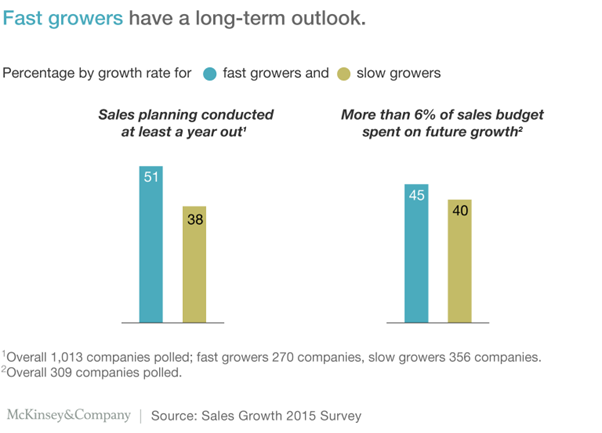
2. Focus on key aspects of digital
Successful brands don’t just “do digital”; they use their full arsenal of capabilities to massively increase the effectiveness of their sales force and to transform the customer buying experience to be “digital first.” It pays off: digital channels provided at least a fifth of 2015 revenues for 41 percent of the fast-growing companies we surveyed—both business-to- business and business-to-consumer—compared with just 31 percent at slow-growing companies.
This trend is only becoming more important, as almost two-thirds of all US retail sales by 2017 will involve some form of online research, consideration, or purchase.
When it comes to customer experience, leading organizations are building out digital routes to market or augmenting traditional direct or indirect sales with digital. For traditional software companies, the focus on SaaS-based products is driving a change toward a digital sales experience where they discover, demo, and trial, all within a few clicks online. Many industrial companies are seeing their products also sold in external marketplaces, which is prompting them to build out their own e-commerce platforms to directly shape the customer experience.
Exhibit 2
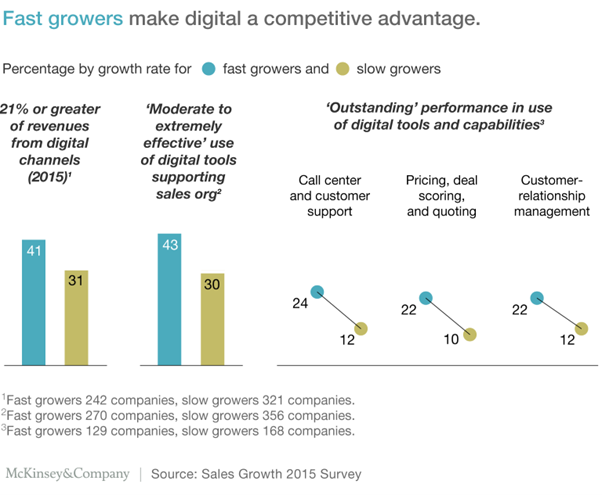
Sales leaders are especially strong at harnessing digital tools and capacities to support the sales organization. Fast-growing companies are more effective than slower-growing ones at using digital tools and capabilities to support the sales organization (43 percent versus 30 percent). They tend to focus on three fronts:
First, they arm sales teams with digital tools that can quickly deliver relevant and usable insights. Second, they treat partners as an extension of the sales force and invest in collaboration tools to improve the flow of data between organizations. Third, they recognize the potential for big micromarket or macrotrend analyses to improve planning and capture opportunities most effectively. As the technology emerges, they are making targeted investments in tools, technologies, and talent to make the most of these opportunities. Success in digital comes from fanatical optimization—not as a one-off project, but as a continuous process. It comes from harnessing mobile technologies to drive growth, understanding how customers use and switch between the mobile channel and other channels. And it comes from integrating digital into a great omnichannel experience that spans marketing to post-purchase.
3. Harnessing of the full range of sales analytics
Only now is the promise of advanced analytics catching up to the hype. Take customer analytics. Companies that use it extensively see profit improvements 126 percent higher than competitors who don’t. And when it comes to sales improvements through the extensive use of advanced analytics, the difference is even larger: 131 percent.
Exhibit 3
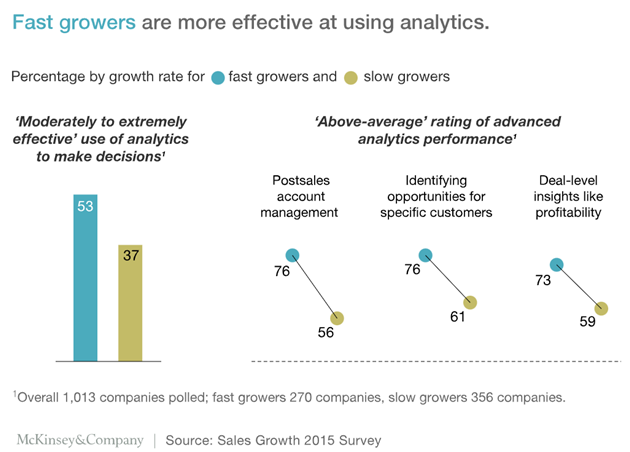
The value of advanced analytics is wide ranging, but where sales leaders excel against their peers is in making better decisions, managing accounts, uncovering insights into sales and deal opportunities, and sales strategy. In particular, they are shifting from analysis of historical data to being more predictive. They use sophisticated analytics to decide not only what the best opportunities are but also which ones will help minimize risk. In fact, in these areas three quarters of fast-growing companies believe themselves to be above average, while between 53 and 61 percent of slow-growing companies hold the same view.
But even among fast-growing companies, only just over half—53 percent—claim to be moderately or extremely effective in using analytics to make decisions. For slow-growing companies, it drops to a little over a third. This indicates that there remains significant untapped potential in sales analytics.
4. Investment in people
A rigorous focus on sales-force training is a clear differentiator between the fast- and slow-growing companies we surveyed. Just under half the fast growers spend significant time and money on sales-force training, compared to 29 percent of slow growers. There’s room for improvement, though. Among fast growers, just over half believe their organization has the sales capabilities it will need in the future, while a third of the slow growers feel similarly equipped. As few as 18 percent of fast growers think they excel at pipeline management, and even in the most successful area—understanding specific customer needs—only 29 percent claimed to be outstanding.”
To continue reading this article, please visit: www.mckinsey.com

Online Article
“In Business, You’re Either Growing Or You’re Dying
By Mark Schellinger, Forbes.com
As an executive member of a business, you’re always asking yourself, “What does it take to build an enduring, great company and to continuously improve and grow?” When one of our co-founders made the statement that “You’re either growing or you’re dying,” my initial knee-jerk reaction was that this was extreme and harsh. I figured his focus on sales and financial growth was driving this conclusion. However, upon further reflection, what he said had so much more to do with growth culture, a strong team and bold goals than simply revenue growth.
Focus On Growth Culture
The growth culture isn’t a component of a company’s strategy, it is the company’s strategy. Growth is a framework that needs to drive all operational tasks, projects and initiatives of a company. The DNA of the company needs to be growth. Opportunities for growth are endless and should always be seized. Companies that don’t grow generally don’t attract the most talented team members (because great people seek growth) and are therefore at a disadvantage from the very beginning.
Growth-focused companies attract the best people, and A-team players want to play with other A-team players, creating a virtuous cycle. These companies invest heavily in the development and growth of their people (above all else) and watch as everyone grows together. It’s understood that the company’s growth is a byproduct of the team’s growth, not the other way around. This positive feedback loop of obtaining great people allows for more growth, which allows for more personal and professional challenges, which in turn allows for more growth that leads to more great people becoming team members (and repeat, again and again). This momentum is everything and it only occurs if a team is constantly growing and pushing their own boundaries and capabilities.
Have Large, Audacious Goals
Operating a small- to medium-size business is hectic, to say the least. Operational fires are always popping up, let alone the endless opportunities for improvements. Having large, audacious goals and working backward allows a team to understand where they are going and how to get there. Having a growth mindset and pushing for these big goals creates an environment of continuous improvement and growth. This environment results in retaining the most talented people.
Growth usually feels scary, it requires additional investment, making choices based on probability-weighted outcomes, constantly weighing and considering opportunity costs and stepping into the unknown. However, by not having these challenges or growth opportunities, you face the bigger risk of not attracting and/or keeping great people, which could lead to your company’s demise. Not to mention, there is likely another competitor in your industry that is focused on growth and will therefore “eat your lunch.”
Clearly, there are no guarantees of getting to where you want to go. However, the only certain way to not get there is to not put a plan in place to get there (i.e., always invert). The growth culture is the largest input into your operational plans and initiatives. It’s reflexive. With a growth culture in place, the company will have larger goals and strategic initiatives and it will be focused on hiring the best people. Furthermore, the team will be focused on achieving more audacious goals and will think bigger, this will lead the team to develop and grow individually, and as a result, the company will grow and will therefore create additional growth opportunities for its team members — and then do it all over again (the virtuous cycle continues).
Invest In Great People — Or Else
Hire great people, invest in them above all else, and the rest will take care of itself. Additional growth opportunities will exist which will keep your great people and allow you to hire even more. Once this momentum is created, the growth of the company will naturally occur. You will inherently outcompete your competitors, you will inherently provide a better product or service, and the positive feedback loop will continue. You either do this or somebody else will, and then your company is destined to fade away.
Although this sounds simple to do, it’s anything but. By constantly investing in growth one needs to accept delayed gratification and be long-term oriented. The growth doesn’t occur overnight — it’s a sustained effort over a long period of time. It’s kind of like losing weight: The idea is simple, but the execution is harder. If you commit to growth you will be more successful and happier in the long run. Remember: In business, you’re either growing or you’re dying.”
To read the full article, please visit: www.forbes.com

Online Article
“Why it’s still a world of ‘grow or go’
October 1, 2015,
Mckinsey & Company.
In a challenging environment, growth matters more than ever.
Growth is magic. It makes it easier to fund new investments, attract great talent, and acquire assets. But the environment for growth has been difficult since 2008, and while there are signs that the Great Recession is at last receding, significant challenges remain. Real-GDP growth in the United States remains below historical averages; the economies of most European countries are still sluggish; and growth in emerging markets, particularly the BRICS countries—Brazil, Russia, India, China, and South Africa—is slowing down.
For more than a decade, we’ve been building and mining a global-growth database containing hundreds of the largest US and European companies. Recently, we’ve been revisiting some of the core analyses in the 2008 book, The Granularity of Growth,1 to see if the challenging environment of recent years has shifted the picture of fundamentals we painted before the financial crisis. The answer is no, though the economic context arguably has increased the importance of an effective growth strategy.
Survival rates
Healthy growth boosts corporate survival rates, which was true in 2008 and remains true in the United States and in other developed markets. From 1983 to 2013, for instance, roughly 60 percent of the nonfinancial companies then in the S&P 500 were acquired—it’s grow or go, and they have gone. Consider these findings over that period:
• Sixty of the 78 S&P 500 companies that generated top-line growth and improved or at least maintained their margins outperformed the S&P 500.
• Companies with deteriorating margins performed less well, even if these companies were growing; just 8 out of 30 outperformed the index.
• A higher percentage (56 percent) of companies that grew slowly, but also aggressively distributed cash to shareholders, outperformed the S&P 500.
As analysis of these companies’ total returns to shareholders (TRS) suggests (Exhibit 1), growth is only a means to the ultimate end: creating value. Not all growth opportunities are equal. Still, there’s no escaping the fact that growth is a critical driver of performance as measured by total returns to shareholders. And TRS underperformers are far more likely to be acquired.
Exhibit 1
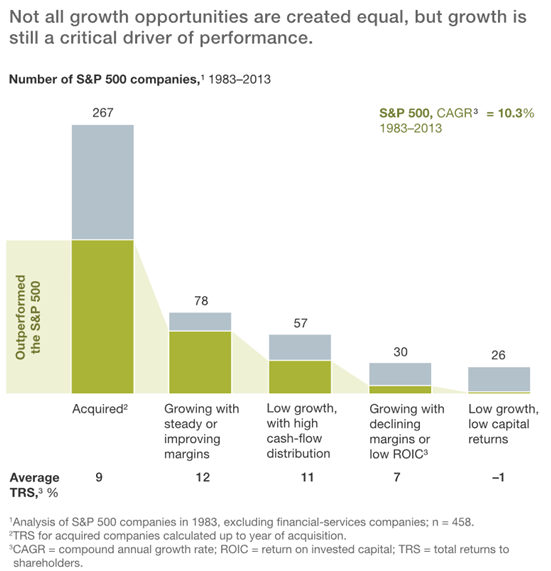
Growth can be sustained, but that’s not easy
Growth must be actively and continually renewed. That may seem like common sense, but sometimes, as Voltaire aptly noted, “common sense is very rare.” When we looked at several economic cycles, we found that very few companies managed to maintain strong growth over time (Exhibit 2). Less than half of the S&P companies that increased their revenues faster than GDP from 1983 to 1993 managed to do so from 1993 to 2003. Fewer than 25 percent of the outperformers of 1983 to 1993 remained in that group through 2013. Similarly, in the eurozone, only about one-third of the nonfinancial companies whose revenue growth outpaced GDP in 1993 also outpaced it through 2013. Nonetheless, some evidence suggests that enduringly fast growth is not a fluke: the rate at which long-term survivors in the United States fell out of the growth-leader category actually decreased over the years. While 62 percent of the companies that outpaced GDP growth after one decade failed to do so after two, only 36 percent of the surviving companies fell away in the decade that followed.
Exhibit 2
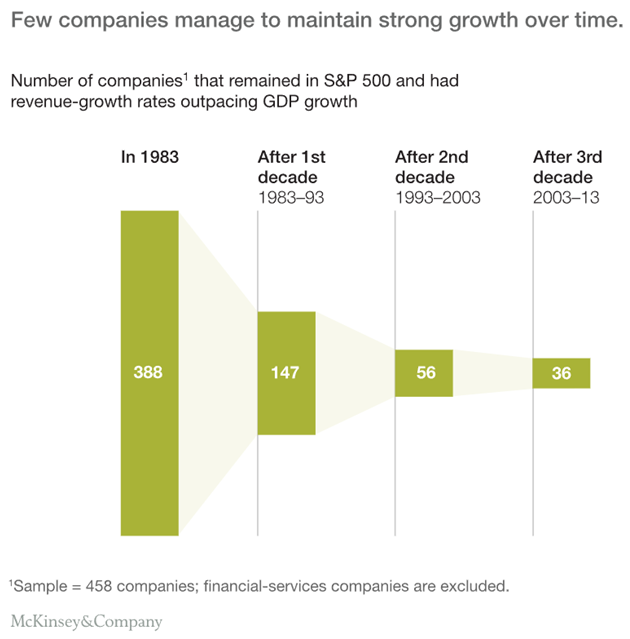
Rethinking where to compete and which assets to buy
A consistent finding in our research is that about 75 percent of all growth is a function of the markets in which businesses compete—portfolio momentum—and the acquisitions they initiate. In other words, just 25 percent of a company’s growth typically comes at the expense of competitors. We highlighted this analysis before the market downturn in 2008, and it has continued to hold true since then.
Making good choices about where to compete requires a truly granular understanding of market dynamics and of a company’s business performance. Opportunities will not always come in traditional or even familiar locales; indeed, from 2010 to 2025, almost 50 percent of global GDP growth will take place in approximately 440 small- and medium-size cities in emerging markets.
Nor do overall averages reliably indicate where the opportunities lie. One company we know had a three-year growth rate that averaged 13 percent across 12 key business units. A closer inspection, however, revealed that their median growth rate was only 2.5 percent. The top-performing unit had been growing at a 62.4 percent clip, but only two others topped the company-wide average of 13 percent. In fact, five of the business units were growing at around 1 percent or less over the three-year period, and the worst performer had been contracting at a rate of close to 5 percent.
Companies can predict their growth momentum by identifying the unique factors that drive their sales and how these factors connect to broader economic developments. To that end, another company we know employs a robust set of tools that go beyond reporting where growth exists at present—it aims to forecast where opportunities will probably arise over the coming quarters. This company starts by feeding its data to econometric models and time-tested algorithms to predict its momentum. Disaggregating the data exposes its market momentum and financial outcomes in the past. Analyzing the data to look for patterns helps to identify shifts, opportunities, and threats indicating potential opportunities in the future.
You can’t grow without reallocating resources
Even the smartest “where to compete” strategy will fail to bring results unless the company that develops it follows through with the strong resolve that can bring it to life. This is among the most challenging aspects of growing in a slow-growth environment. In such times, companies don’t have the benefit of a rising tide to generate surpluses for new initiatives—pushing into new markets, acquiring existing businesses, or focusing on promising products or services.
But while it’s easy to agree that growth is imperative, it’s not always clear how to achieve it. Managers are often uncertain whether the answer lies in expanding beyond the core. When we surveyed more than 600 executives from developed markets, fully 75 percent believed that the share prices of their organizations would increase over the next five years if they pursued a new activity outside their core business. At the same time, though, more than half of the respondents assumed that growth would result from refining the corporate focus. When we asked them what would happen if their companies divested a current noncore activity, for example, 54 percent predicted that share prices would rise over the next five years.
There’s an element of truth to both perspectives. Businesses decay, and yesterday’s core may not be today’s or tomorrow’s. Getting free from a decaying business is different from investing in one with a strong potential. But the two perspectives may become linked through the reallocation of scarce financial and human resources. Companies must often let go of businesses that were once important and focus on up-and-comers. But it can be hard to jettison businesses that management grew up with or to accept that they can’t be turned around enough to justify further investments.
Hard but important. A leading global industrial manufacturer we know assessed the profitability, growth, market attractiveness, competitive positioning, and other dimensions of the products and components produced by its largest business group. This analysis revealed opportunities to reallocate tens of millions of dollars to business areas that could deliver significantly better returns than existing priorities did. It also highlighted ways to raise the bottom line quickly and thus to overcome initial misgivings that these moves might sabotage the company’s short-term performance.
Capital-market pressures and organizational dynamics can make it difficult for companies to place big, long-term bets on the growth opportunities of tomorrow. And the bigger you are, the harder it is to grow. That said, outperforming the competition remains possible in all industries, even in sluggish economic times. But this takes discipline and a relentlessly granular analysis, as well as a commitment to seek the kind of growth that generates real and sustainable value—the most important objective of all.”
To read the full article, please visit: www.mckinsey.com
Course Manuals 1-12
Course Manual 1: Survival
For many business owners, the whole idea of growth can be frightening. However, without expansion, your company may eventually become uninteresting, stagnate, or even fail. It’s important to understabt why you might be resisting business growth and why growth is so crucial.
Why business owners resist growth
Complacency is the most frequent cause of business owners’ resistance to expansion. Many business owners are content with the way their firm is performing right now and don’t see a need to change anything. You’ve heard the saying, “If it ain’t broke, don’t fix it.”
Additionally, there are hazards associated with growth. There is never any assurance that your new endeavor will be profitable. If your expansion plan involved an additional investment or higher costs, these risks are enhanced even further.
Control over the company comes next. Growth could result in a larger office, more staff, a longer client list, and more goods. As a business owner, you might enjoy having total control over every area of your enterprise, but as it expands, you might find yourself needing to outsource some of these responsibilities.
For a business to survive, growth is an imperative, not an option.
Less than ten percent of businesses are successful in attaining long-term growth. The fact that “70% of CEO/MDs surveyed claimed they failed to grow owing to a lack of managerial focus” is even more alarming is disturbing. They gave controllable actions, such lack of concentration, poor judgment, and the inability to create a successful growth strategy, as the reason. – Zook and Allen, The Facts about Growth, Bain & Co.
In today’s constantly shifting environment, delivering business growth is frequently complicated and difficult. It’s even harder to deliver sustained corporate growth.
It’s likely that if you questioned 100 businesses about their aspirations for long-term business growth, they would all respond “yes,” but why?
People work to achieve long-term business growth for a variety of reasons, including the desire to be a part of a larger movement and to play for the winning team, in addition to the need to make profits (which is what keeps the firm alive for the aim of continuing growth).
This idea is reinforced by psychology and our innate tendency toward favoritism of our own group. Our efforts to foster long-term corporate growth and success serve as a way for us to identify with the organization and ensure its continued existence beyond the basic desire to “do good.”
So how do we create sustainable business growth?

Importance of Thinking Long-Term in a Short-Term Market
In recent years, business has become more and more focused on quick wins and returns. The Harvard Business Review reports that CEOs are under increasing pressure to present quarterly results, with many even bowing in to the demands of the market.
The pressures of short-term performance have led to many high-profile incidents just last year where businesses have abandoned their brand and long-term strategy. Mark Zuckerberg, the CEO of Facebook, testified before Congress in just April of last year regarding the company’s apparent disrespect for customers’ privacy in relation to user data leaks for immediate financial gain.
The Wells Fargo controversy involving phony accounts, an American financial services organization, contributes to the discussion of what occurs when businesses prioritize immediate profits over all other considerations. It became clear during the Banking Committee hearing how the bogus account crisis came about: staff were under pressure to hit short-term goals.
While it has advantages, only concentrating on short-term objectives and stock prices doesn’t actually benefit shareholders. According to a study by The McKinsey Global Institute, corporations that were committed to long-term plans saw their earnings grow on average 36% higher than other companies.
Planning for Long Term Business Growth and survival
A company can expand in a variety of ways. The more popular strategies for expansion include diversifying your portfolio of goods and services, growing internationally, enhancing competitive advantages, and identifying unrealized potential.
All of them are excellent ways to foster business expansion. Some solutions can be more appropriate for your business and the market than others. But preparation is one essential component that is necessary for all of these methods to succeed.
Planning is a term that people either love or loathe, but it is still a crucial step in any well-thought-out company solution. A strategy without planning may not realize the full potential of the company’s core business, over-diversify and weaken the base of the brand, or ignore new needs of the business and fail to adapt to them.
The Startup Genome Report estimates that 90% of firms that fail do so primarily as a result of “self-destruction.” Meaning that failures were primarily brought about by the founders’ own poor decisions or lack of preparation, rather than by bad luck or other market circumstances. Therefore, if your company has already made this much progress, it will be good to invest a little more time and energy in developing a plan for the future growth of the company.

The Hidden Strategy for Business Growth in the Long Run
Many businesses in the growth and expansion stage disregard brand licensing and/or brand extension plan as a line of growth strategy. In fact, a common error made by businesses under pressure to expand and provide results is to completely ignore brand.
By exponentially increasing the company’s reach, brand expansion strategies are a terrific way for growing enterprises to grow even faster. By extension, brand expansion is a strategy for maximizing a brand’s development potential by leveraging its existing strong credibility and reputation to support sub-brands and new product lines.
Sub-branding is one method of brand extension that helps build brand loyalty and trust while expanding visibility for the parent brand.
Brand extensions that are successful produce a variety of items while maintaining true to the essence of the parent brand. Caterpillar is one business that excels at doing this. They utilized their credibility to enter the footwear, apparel, luggage, watches, and other markets, extending their reach from the B2B into the B2C market. They had established a reputation in the construction business as a brand that represented toughness and rough durability.
Businesses establish product and emotional continuity through brand growth, increasing the brand’s overall lifespan. In fact, branding is important for growth, according to 77% of B2B marketing leaders surveyed by Circle Research. This was corroborated by studies from Lucidpress, which showed that consistent brand presentation led to an average 23% increase in revenue.
How therefore can you ensure that your company grows over the long run and endures in these trying times? Here are 3 recommendations and key points:
Find the best people to grow your brand
Because of the recent record-low unemployment rates, businesses are having a harder time attracting the proper talent, which is more the reason why companies should prioritize recruiting the best marketing and HR staff first. By doing this, businesses can establish a solid base and better utilize their brand to draw in the ideal clients.
Incorporate a diverse range of strategies
When considering their chances of survival, businesses must employ a combination of short-, medium-, and long-term plans. Finding strategies to streamline and long-term optimize your current procedures is one way to accomplish this.
Don’t neglect your brand
Businesses frequently overlook the value of brand when under pressure to expand. We must remember, too, that well-known businesses like Google and Apple are leaders not only because they create excellent goods and services, but also because they take pride in their reputation. Alphabet Inc., more often known as Google, is valued at $286.25 billion USD (Source: Investopedia), which is a wonderful example of why businesses should consider branding.

Course Manual 2: Increase Sales
The only way for a business to remain viable in the market is through sales.
They are crucial to the expansion and improvement of a business. What then prevents a business or brand from making additional sales? What are the typical issues that firms encounter? How would you stop that?
How Important are Sales for You as a Business?
As everyone is aware, a company’s primary source of income is sales. Without such, a business will experience a significant loss. It is a truth that everyone agrees upon. It is crucial to the company’s ability to compete in the market.
Aside from that, sales are essential for –
1. Building Loyalty
Only if you have active sales will a customer recognize your name, products, and services. They won’t tell their friends and relatives about your brand unless they notice your business expanding. And to everyone they believe will profit from your good or service. When a brand is personally recommended by those whose opinions they value the most, consumers are more likely to trust it. Because of this, a firm depends greatly on its customers’ favorable comments and sales. You can only develop customer loyalty and relationships if you have a healthy number of sales and turnover each month. This will significantly expand the audience for your brand and accelerate its development.
2. A Good Relationship with Customers and Employees
Gaining qualified leads and customers who are also valuable to you is made possible by effective sales.
The staff of the company would be content as well if the company was making strong sales. And in fact, it will improve employee performance and allow them to carry out their tasks in a more orderly and professional manner. Employees are a company’s foundation. Therefore, if many of your employees are content with the sales and the company’s expansion, it will show in the level of service they are giving to customers. it fosters a wonderful, positive work environment and culture.
Let’s now examine the factors that are preventing you from making additional sales.

Reasons for Struggle in Sales and Ways to Tackle Them
Some frequent challenges that brands and enterprises typically encounter in their early stages include positioning oneself as a brand in the market, handling leads that are handled by one person, and being uninformed of competitors’ strengths.
Other typical problems have been identified so you won’t experience them again when you launch your brand and business.
1. Lack of Understanding of Target Audience
Not having sufficient understanding of your target audience is the first significant issue that contributes to sales difficulties. Not anyone can be regarded as a member of your audience. If you believe this, you do not fully comprehend your brand. There will always be certain audiences for a brand who may be more interested in the goods than most others. So determining your target audience is the first step that will help you increase sales.
2. Inadequate Content
The king of internet marketing is content. Good content draws customers and creates leads for your business. and cultivates bonds with your clients. The best method to capture your audience’s attention is with engaging content that helps them out. Additionally, giving them solutions to their concerns is always a win-win situation and a surefire method to boost your sales.
3. Making Your Presence Online
The ideal location to market your company is online, and social media is the go-to platform for engaging with customers, generating leads, and attracting high-end buyers. Therefore, you may boost your sales if you are consistent and continuously posting the appropriate material using the appropriate combination of methods.
4. Wrong Usage of Talent
Ensure that your staff is well-equipped with the necessary tools and knowledgeable about the work they are performing. Because neglecting to provide them with the proper tools, the freedom to work, and the opportunity to implement their ideas will hurt your sales and do you no good at all. Therefore, you must make sure that you invest your time and money to give them the appropriate tools for their suitability because only then can they contribute to the growth of the business and increase your sales to the fullest.

Increase sales to existing customers
Depending on your situation and how well your firm is doing, you can choose several strategies for boosting sales. You may decide to concentrate on the clients who have already made a purchase from you, or you could strive to attract new clients locally, nationally, or internationally.
Selling more of the goods or services you are now selling to the clients who are already purchasing them is the simplest approach to boost your sales. In the majority of cases, this entails:
• Converting one-time customers to repeat buyers
• Identifying clients who have stopped purchasing from you and attempting to convince them to do so again by offering your regular customers more of the same goods or services
You may determine who has stopped buying from you and who would consider purchasing more by keeping track of your consumers and the products you sold to them. Instead than looking for new clients, focusing on these existing ones is frequently less expensive and more productive.
Review your prices
Regularly assessing your rates and comparing them to those of your rivals can be a good strategy to boost your revenue, profitability, or both.
Before making any modifications, you should try to predict the likely impact of various pricing changes on the sales, cash flow, and profitability of your organization. To accomplish this successfully, you must comprehend:
• The “cost structure” of your company (which includes routine “fixed” expenditures and “variable” costs that fluctuate based on your company’s activity)
• The worth that your clients place on your goods and services
It’s important to keep in mind that, even if your sales increase, giving a discount occasionally lowers your overall profitability. In addition, even if you sell fewer things overall, you might be able to increase your profit margin by raising your prices.
Small price adjustments, such as offering loyalty programs or group discounts, can boost sales from both current and former clients.
Example
Every tenth time a customer chooses the deluxe option, a vehicle wash will give them a free cleaning. Profits increase even when they are giving something out for free due to the value of repeat business from devoted clients.
With additional clients, it would probably have cost much more to produce the same volume of sales, which would have reduced earnings.
Additionally, you should frequently compare the prices you are charging for your goods and services to those of your rivals. You can use this to determine whether you are:
• Because clients are prepared to pay more than you are charging them, losing customers who can obtain the same good or service elsewhere for less money may compromise profitability.
You could need to extend your market, strengthen your marketing efforts, roll out new products or services, or enhance customer service in order to boost sales. If you’re a manufacturer, this can entail raising your output to keep up with demand.
Introduce new products or service
Offer your customers a wider selection of goods or services. To determine whether there is a demand for your proposed offering, you must conduct market research. Think about using some of your current customers as a test group. You can reduce some of the risks and learn how to enhance the product or service by getting feedback from a test group. Give marketing and promotion of your new goods and services extra thought so that people are aware of them.
Expand to new domestic markets
Although entering new markets can be expensive, doing so can grow your clientele. You can develop a strategy and better comprehend the prospective new market with the aid of market research. To accommodate the new demand, you’ll also need to think about marketing, sales, distribution, and raising your production.
Enhance your sales channels
You might be able to grow your market control, expand your clientele, and boost profitability by analyzing and improving your sales channels. For illustration, you could:
• Improve the training of your sales staff Engage independent sales agents or hire your own
• Add stores to the list
• Employ resellers
• Implement an online business plan.
Marketing activities
You might be able to make your marketing efforts more effective. Keep an eye on the results of your current marketing or advertising, and be ready to alter your strategy if necessary. Analyze the best ways to reach your target audience and adjust your marketing strategy accordingly.
Change your price
Changing your rates, terms, or billing requirements could increase demand for your goods and services on the market. To see if you can cut costs, be aware of what your competitors are offering and what your own profit margins are. If you can’t cut your pricing, you can frequently sway clients by making a better deal with advantageous terms.
Be aware of the competition
Always be on the lookout for what your rivals are doing. You can better comprehend their behaviors, abilities, and constraints with the aid of this knowledge. Knowing this will improve your ability to protect your market position, respond to changes, and discover new markets.
Improve community relations
Become more noticeable and present in your neighborhood. You may increase customer awareness of your company and boost sales by taking part in activities like sponsoring neighborhood events, giving speeches, and supporting a local sports team.
Don’t neglect customer service
Be mindful of how the customer may perceive the effectiveness or responsiveness of your customer service. A satisfied customer’s good word of mouth is beneficial to your business.
Know when to stop
It might be time to get rid of any markets, services, or product lines that have low profit margins or high selling costs. Getting rid of less lucrative goods or services can be challenging if you are committed to your current offers, but doing so can help you save money and enable more strategic reinvestment.

Course Manual 3: Increase Market Share
What Is Market Share?
Market share is the percentage of a company’s industry’s total revenues that it generates. The company’s sales for the time period are divided by the total sales for the sector for that time period to determine market share. This metric is employed to provide a basic understanding of a company’s size in relation to its market and rivals. The business with the biggest market share in a certain sector is the market leader in that sector.
Understanding Market Share
The percentage of total revenues that a company generates relative to the market or sector in which it competes is known as market share. Select the time period you wish to look at before beginning to calculate a company’s market share. A fiscal year, year, or a number of years may be involved.
Next, determine the overall sales for the company during that time. Then, ascertain the industry’s overall sales for the company. Lastly, divide the company’s total revenues by the total sales in its sector. For instance, if a firm sold $100 million worth of tractors domestically last year and $200 million worth of tractors were sold in the U.S., the company’s market share in the U.S. for tractors would be 50%.
Companies typically report their market share in North America or Canada when calculating market share for particular nations or regions. Market share information is available to investors from a variety of independent sources, including trade associations, regulatory agencies, and even the firm itself. However, certain industries are more difficult to quantify accurately than others.
Formula for Market Share
Total Company Sales / Total Industry Sales is market share

Benefits of Market Share
Market share growth and declines are closely watched by investors and analysts because they might indicate how competitive a company’s goods or services are. A company that is maintaining its market share is growing revenues at the same rate as the whole market for a good or service. A company’s revenues will increase more quickly than those of its rivals if it is increasing its market share.
Depending on the state of the industry, changes in market share can have a big impact on a company’s stock performance.
Gaining market share can enable a business to expand its operations and boost profitability. A business may strive to increase its market share by providing new or different items, cutting prices, or employing advertising. In addition, by appealing to additional audiences or demographics, it can increase the amount of its market share.
Market Share Impact
Changes in market share have a greater effect on a company’s performance in cyclical or mature industries with limited growth. Companies in industries that are experiencing growth, however, are less affected by changes in market share. Because more people are entering these markets, businesses can still increase revenues even though they are losing market share. Sales growth and margins have a bigger impact on a company’s stock performance in this situation than other factors do.
Market share is fiercely competitive in cyclical sectors. In comparison to other aspects, economic considerations have a greater impact on the variation in sales, earnings, and margins. Due to competition, margins are often minimal and operations are handled as efficiently as possible. Since sales are made at the expense of competing businesses, some businesses extensively invest in marketing initiatives or even use loss leaders to boost sales.
Companies in these sectors might be prepared to temporarily lose money on their products in order to pressure rivals into folding their tents or going bankrupt. They try to increase prices once they have a larger part of the market and their rivals have been driven out. This tactic can either succeed or fail, compounding their losses. As a result, several industries are dominated by a small number of powerful companies, such as discount wholesale retail, which includes Sam’s Club, BJ’s Wholesale Club, and Costco.

Why Is Market Share Important?
Simply said, market share is a crucial measure of how competitive a business is. A company’s profitability may increase as a result of growing its market share. This is due to the fact that as businesses grow larger, they may scale as well, allowing them to cut their prices and restrain the expansion of their rivals.
Companies have been known to operate some divisions at a loss in an effort to drive competitors out of business or into bankruptcy. After this, the business might grow its market share and raise prices even further. Market share has a significant impact on stock prices in the financial markets, particularly in cyclical industries where margins are thin and competition is severe. Any significant variation in market share may cause investor sentiment to be weak or strong.
What Strategies Are Used to Gain Market Share?
One of many strategies may be used by a corporation to increase its market share. First, it might use new technologies to draw clients who might have otherwise chosen its rival. Second, encouraging customer loyalty is a strategy that can lead to both a strong foundation of current clients and word-of-mouth growth. Third, a corporation can focus more on its core strengths by prioritizing its core competencies rather than incurring expensive staff turnover costs. Last but not least, a corporation can acquire a competitor’s customer base while also reducing the number of competitors.
What Is a Low Market Share?
A market share that is less than half that of the leader in the industry is seen as being low. The company with the 10% market share would be regarded as having a low market share because 10% is less than 20% (or half of 40%), the market share of the industry leader, which is 40%.

Why market share is important
You acquire a great deal of insight that can aid your marketing once you have the data to assess your market share. Here are our top five justifications:
1. Understand the market better and see what your competitors are doing
This is a big deal. You’ll be able to benchmark your work after viewing your performance and that of your rivals. You can determine recurring keyword themes and perhaps even narrow it down to particular terms. You can use this to inform all of your marketing efforts and upcoming initiatives. Are you, for instance, ranking for a diverse and broad range of keywords that will allow you to compete in this market if a certain theme is strong? Are you gaining traction for keywords where your rivals are struggling? If so, consider your options for maximizing this chance and ensuring that your voice dominates the market.

2. Identify new opportunities
You might run upon topics that your rivals are ranking for but you are not. It is crucial to keep in mind that not all of them will be pertinent. You may become so engrossed in what your rivals are doing that you may forget about your own USPs, what you have to offer, and the possibility that you aren’t offering precisely the same goods or services.
If you do discover that your rivals have a greater voice share in a certain theme, consider whether or not this applies to you. What categories of keywords do they rank in? What can I do to strengthen my standing in the market? This can be a terrific approach to discover fresh subjects for your content or the potential impact that underutilized long- or short-tail keywords may have on your company.
3. Quantify the impact of your strategies and tactics
You may measure your visibility before and after campaigns or targeted ongoing marketing activity by understanding your market position. It provides you with a standard for what works and what doesn’t, as well as guidance on how you may improve your effectiveness for upcoming campaigns.
4. Ask questions on performance you didn’t think to ask
Marketers adore statistics. When you have accurate statistics in front of you, you may be in a better position to think critically and delve a little further to completely understand your performance. You might discover data that surprises you, at which point you can inquire about its importance and how it can improve your marketing initiatives.
5. Respond to emerging trends and judge total market growth or decline
You can stay on top of new trends if you maintain your research up to date and include new rivals. You’ll be able to determine whether some keywords are less efficient than others, and you’ll be prepared to adjust your marketing strategy. Make sure to combine this with other activities, such as looking at Google Trends, so you can profit from the queries and responses of your target audience.

Market Share Examples
The market share of particular markets serves as the benchmark for success for all multinational firms. Due to its continued rapid growth as a market for numerous items, China has been a significant market for businesses. For instance, Apple Inc. measures the growth of its business using data on its market share in China.
Apple Inc.: Apple is a great real-world example of a company that has a sizable absolute market share and rules the sector in which it competes. It is one of the market leaders in the smartphone sector, competing against Samsung and Huawei, two extremely potent rivals. The bulk of the markets in which Apple is present see an average market share of 70% for the US-based business.
Colgate: Another great example of a business with a sizable absolute market share is Colgate. Colgate is responsible for more than 80% of all toothpaste sales in the market.
The Bottom Line
Market share is the percentage of a company’s total industry sales. A corporation has more sales than its rivals in its particular industry the higher its market share. Market share is a measure of a company’s size and level of influence within its sector. It may also be a sign of development and achievement.
In general, businesses aim to grow their market share. You can achieve this through introducing new technology, providing a product of higher quality, using smart marketing, purchasing rival businesses, and cultivating consumer loyalty.

Course Manual 4: Greater Power to Control the Market
Understanding Market Power
Market power can be defined as the degree of control a corporation has over setting market prices, either specifically for a given product or generally across its sector. In the smartphone market, Apple Inc. is an illustration of market strength. Apple’s iPhone product has a sizable amount of market share and customer devotion, therefore even though it cannot entirely control the industry, it has the power to influence overall pricing in the smartphone market.
When there are several firms manufacturing rival goods and no firm has a sizable amount of market power, the market is said to be in a state of perfect competition, which is the ideal situation. Producers have little control over pricing in markets with perfect or almost perfect competition, forcing them to act as price takers.
That is, of course, only an ideal that is rarely realized in reality. Antitrust laws and other similar laws are in place in many nations in an effort to restrict the market dominance of individual companies. Market power is frequently taken into account when governments approve mergers. If it is thought that the combined business would establish a monopoly or would have excessive market power, a merger is unlikely to be permitted.
Even more so than the existence of competing suppliers of a product, the scarcity of a resource or raw material can have a substantial impact on pricing power. For instance, even though there are competing providers and competition in the market, certain threats, such as disasters that put the supply of oil at risk, result in increased rates from petroleum businesses. Because of the limited supply of oil and the extensive reliance on the resource across many industries, oil corporations still have a large amount of pricing power.
An Example of Market Power
For instance, when Apple first released the iPhone, the corporation possessed significant market power since, for a brief time, it held the monopoly and effectively defined the smartphone and app markets.
Due to the dearth of competing products at the time, purchasing an iPhone was expensive and could continue to be so. As a result, Apple, rather than the open market, initially set the pricing of the iPhone. The iPhone remained to represent the top end of the market in terms of pricing and expected quality even after the first rival smartphones appeared. Apple’s market dominance dwindled as the competition caught up in terms of service, app quality, and accessibility.
As new competitors entered the market, the iPhone did not disappear. Apple started releasing new iPhone models in a variety of configurations, including more affordable models aimed at users with tighter budgets.
The 1933 book “The Economics of Imperfect Competition” by Joan Robinson posited monopolies, or markets where one buyer has absolute market power.

Power Structures of Markets
There are three main market power conditions that can be applied to either the broader economy or a market for a particular good.
The first is the previously mentioned perfect competitive optimum circumstance. In a market with perfect competition, there are many businesses manufacturing the same or a comparable product, but there are also little or no barriers to new businesses entering the market. Since it is practically hard for any producer of an agricultural commodity to acquire a significant level of market power, agricultural markets are sometimes cited as examples of essentially perfect competition marketplaces.
A monopoly, in which one business totally dominates the market for a good or service, or at least a portion of the overall market, and is able to change prices at will, is the antithesis of ideal competitive circumstances. Utility firms frequently enjoy limited monopolies, although their capacity to increase prices is typically constrained by governmental authorities.
A market that is dominated by a limited number of businesses and where new competitors face significant obstacles is referred to as an oligopoly. In an oligopoly, the firms typically have combined market power rather than individual market dominance. The cellular service market, which is dominated by a limited number of companies and has high hurdles to entry, is an example of oligopoly.

Factors influencing Market Power
1. Number of competitors in a market
A corporation needs to have little rivalry in its industry of operation in order to enjoy significant market power. The number of businesses in a market has an adverse relationship with its market strength. Each participant will have more market power because there are fewer companies.
2. Elasticity of demand
Demand for a company’s goods must be rigid in order for it to have market dominance. This indicates that there is a constant need for the goods, regardless of its price. Businesses can achieve an inelastic demand curve by offering distinctive goods and services that benefit the client.
3. Product differentiation
A corporation may, to some extent, set the price for its goods and satisfy customers’ inelastic demand if it has a wide market share or differentiated products and services. A corporation can develop market power by having strong pricing power.
4. Ability of companies to make above “normal profit”
It is impossible to generate above-average profits over the long run in a market that is perfectly competitive and in which both buyers and sellers are price takers. If there is a situation in which businesses can achieve earnings that are higher than the typical profit range, more businesses will enter the market in an effort to achieve the same results, which will weaken the position of each company and return the profits to the average. A business with significant market sway will be able to generate earnings above what is considered “normal profit.”
5. Pricing power
A corporation can, to some extent, set the price for its goods and satisfy inelastic demand from customers if it provides exceptional goods and services or has a sizable portion of the market. A corporation can develop market power by having strong pricing power.
6. Perfect information
Players won’t gain market power in a market where information is perfectly flowing and there is no discrepancy between the facts and the information available to sellers.
7. Barriers to entry or exit
When entry into a market is difficult, the existing firms often have a monopoly. High entry barriers preserve the market’s current players since it makes it difficult for new players to enter and disrupt it.
8. Factor mobility
The market power of individual companies will not increase if an industry allows for equal ease of access to the inputs that go into its goods or services.

Market Power in Different Market Concentrations
1. Perfect competition
In a market with perfect competition, numerous vendors provide the same product to numerous customers. A homogenous market has many vendors who are free to enter or depart the market. There are no entry barriers, and businesses cannot sustain longer-term profits above “normal profits.”
In a totally competitive market, customers will receive perfect information about the good or service. Since every commodity on the market is a substitute for every other product, demand for goods is very flexible. All businesses have no market strength and are all price takers.
2. Monopolistic competition
A type of imperfect competition known as monopolistic competition occurs when a small number of vendors dominate the market by differentiating their goods through branding or customizing. These characteristics prevent the products on the market from becoming exact equivalents for one another, and sellers are able to set prices.
However, since businesses finally adapt their products to the needs of the market, demand eventually becomes elastic. Entry barriers do exist, but they could be modest. The buyers and sellers do not have complete information; this leaves room for uncertainty that a more knowledgeable participant can take advantage of. In a monopolistic market, sellers have the authority to set prices.
3. Monopoly
In a monopoly, one business is the sole provider of a specific kind of good or service. The products are not simply modified for a particular specialized group within their industry. Due to the distinct character of the product, the demand is still inelastic, allowing the business to maintain significant pricing power and generate profits above “normal earnings.”
Due to the possibility of patent protection for the existing company and the absence of the mobility factor, the industry is characterized by exceptionally high entry barriers. Since buyers cannot obtain perfect information, a lone seller may occasionally take advantage of the market by engaging in price discrimination. The market dominance of a monopolistic company is exceedingly strong, if not absolute.

Top 8 Examples of Monopoly in Real Life
Here are some actual monopolies from everyday life.
Monopoly Example #1 – Railways
Like the railroads, the government offers public services. Since no new partners or privately held enterprises are permitted to operate railways, they have a monopoly. The cost of the tickets, however, is affordable enough for the majority of people to use public transportation.
Monopoly Example #2 – Luxottica
Luxottica – a business that controls all the major sunglasses companies. The business has acquired practically all of the main eyewear manufacturers. They still have different names, though. Although they are all made by the same business, it gives the impression to the buyer that they have a selection of sunglasses to pick from. More than 80% of the eyeglasses sold worldwide is produced by Luxottica.
Monopoly Example #3 -Microsoft
Microsoft – Microsoft is a company that makes computers and software. It dominates the tech market and effectively monopolizes it with a share of more than 75%.
Monopoly Example #4 – AB InBev
AB InBev – More than 200 brands, including Budweiser, Corona, Beck’s, and others, are distributed by a business created by the merger of Anheuser-Busch and InBev. These beers all come from the same manufacturer, despite having various names and compositions that result in various tastes. So, in a way, consumers of many Beers are paying a single business.
Monopoly Example #5 – Google
Every time we don’t know the answer to something, we usually turn to Google for assistance. The largest web search engine holds a market share of more than 70% thanks to their proprietary algorithm. Additionally, the business has developed into a web of connected services, including search engines, Gmail, maps, etc. As a result, the business has advanced technologically and innovated more than its rivals Yahoo and Microsoft.
Monopoly Example #6 – Patents
With the exception of a brief window, patents grant a business a temporary legal monopoly. No other business is allowed to exploit the invention for its purposes while the patent is active. For instance, a casino in Malaysia’s Genting Highlands had the sole patent for a permitted casino and had years of legal monopoly in that country.
Monopoly Example #7 – AT&T
The antitrust rules were broken in 1982 when AT&T, a telecommunications company, was the only provider of telephone services nationwide. The corporation was compelled to divide into six companies known as “Baby Bells” because of its monopolistic practices for service as a necessary telecommunication.
Monopoly Example #8 – Facebook
The new market in the twenty-first century is social media. Services are provided without charge to users, but businesses make money via advertising. Facebook nearly controls this market thanks to its enormous market share. The business is in front of all of its rivals, including Twitter and Google+. Users have increased organically, and social media marketers and other businesses, such as WhatsApp and Oculus Rift, have been acquired. The corporation is so large that it was recently accused of influencing users’ opinions about how elections are contested and swaying them in favor of a particular candidate or political party.

Course Manual 5: Increase Profits
Any business’ success hinges on its capacity to generate profits over time. Revenues less expenses are the company’s profits. Any firm that wants to succeed needs to make a profit since doing so affects whether it can get bank funding, draw in investors to fund its operations, and expand. Without making a profit, businesses cannot stay in operation.
Benefits of Profit
1. A rise in tax collections. Corporation tax revenues will increase as business profits increase. This makes it possible for the government to spend more on welfare, education, and other public services. Therefore, an increase in corporate profit indirectly helps all taxpayers.
• The rates of corporation taxes have, however, decreased recently. Rates of corporation tax have decreased to 19% in the UK. As a result, the general taxpayer only receives one-fifth of the company’s profits.
• Large multinational corporations have also been quite good at transferring profits through nations with the lowest tax rates in order to avoid paying corporation tax. For instance, in order to benefit from low tax rates, Google, Microsoft, and Apple established operations in Ireland. Although Amazon has a significant turnover in numerous EU nations, it registered in Luxembourg to take advantage of lower tax rates.
2. Development and research Increased company profit enables businesses to increase their R&D spending. Long-term improvements in products might result from this, which is good for customers. This enhancement investment makes it possible for more dynamic efficiency. For industries that demand a lot of investment and research, it is crucial. For instance, when record labels are profitable, they have the funds to spend on discovering new musical ensembles and artists. Drug corporations assert that in order to fund the creation of new medications, they must generate a significant profit.
• The amount of earnings that is reinvesting in R&D, however, is up for debate. If businesses produce more money, they might only utilize it to increase manager salaries and dividends to shareholders. In this way, businesses are redistributing revenue from the rich to the poor rather than offering a social benefit.
3. Increased shareholder dividends. Good news for shareholders who will receive more dividends is a higher profit. Workers with private pensions will indirectly reap some benefits. due to the ownership of profitable enterprises by pension funds.
• Nevertheless, it is a highly indirect benefit, and those who are wealthy will stand to gain the most.
4. Effects of incentives. Profit is a significant motivator for people to make investments, develop, and take risks. More business owners will take chances and make investments as profitability rises. Increased economic prospects, additional jobs, and greater growth may result from this.
5. Signal impact. Profit serves as an indication for areas of increased demand. Industries that are extremely profitable should draw new businesses to the market and encourage them to raise their investment. For instance, the profitability of mobile phones drew additional businesses into the market and encouraged them to grow. Technology quality has improved quickly as a result of this.
6. Savings. Profit can be used to build savings for a cyclical downturn and prevent businesses from going out of business.

Types of profit
Three main categories of profit are listed in income statements. Each type of profit provides management and other stakeholders with important information about the company’s health.
Gross profit
The form of profit that appears initially on the income statement and frequently has the biggest amount is gross profit. The company’s revenue less its cost of goods sold, or COGS, is its gross profit. The gross profit enables businesses to calculate their earnings after deducting the direct costs of producing their good or service. Subtract the COGS from the total sales to arrive at the gross profit.
Operating profit
On the income statement, operating profit is lower than gross profit. Both the COGS and the cost of operational costs are taken into account. Businesses can assess how direct expenditures, such as personnel and equipment, and indirect costs, such as building rent and utilities, reduce earnings using the operating profit. Subtract operational expenses from gross profit to determine operating profit.
Net profit
The bottom line, or net profit, is the total profit shown on the income statement. Net profit is the amount of revenue that is left over after all business costs, such as taxes and interest, have been taken into consideration. The amount of money left over after covering all expenditures and expenses is what the bottom line actually means when describing how healthy a corporation is. Operating profit is divided by tax and interest expenses to determine net profit.
To determine their profit margin—or how well they use their profits—companies might use gross profit, operational profit, and net profit. Divide the gross, operating, or net profit by the total revenue to get the profit margin. Significant profit per dollar of revenue is indicated by high profit margin ratios, whilst poor profit per dollar of revenue is indicated by low profit margin ratios.
Profit margins can also be used by external parties, such as investors, to evaluate the worth of various business sizes. For instance, a large company might make significantly larger profits than a small company, but the latter might have a lower profit margin, making the former a better investment given the former’s higher efficiency.

The Difference Between Profitability and Profit
Profit and profitability are not the same things, despite the fact that they are frequently used interchangeably. Both accounting criteria are used to assess a company’s financial performance, but there are clear distinctions between the two. Investors must first comprehend what separates a firm’s profit from its profitability in order to properly assess whether a company is financially stable or positioned for growth.
The amount of income or revenue a business generates above and above its costs or expenses determines its profit, which is an absolute number. It can be found on an organization’s income statement and is computed as total revenue less total expenses. The goal of a business is always to turn a profit, regardless of the size, scope, or sector in which it engages.
Profitability and profit are closely connected, but with one significant exception. Profit is a relative concept while profitability is an absolute one. It is the metric used to assess the extent of a company’s profit in light of its market share. Efficiency is measured by profitability, which determines whether an endeavor succeeds or fails. A business’s capacity to generate a return on an investment based on its resources in comparison to an alternative investment is another definition of profitability. Although a business may make a profit, this does not imply that the business is profitable.
Both profitability and growth are crucial and essential for a company to thrive and remain appealing to investors and analysts in order to be successful and stay in business. A corporation must be profitable in order to survive, but expansion is also essential for long-term survival.
Profitability
The revenue remaining after all costs associated with the creation, production, and sale of items have been subtracted is the company’s net profit. Money in the bank is profit. It either goes straight to a company’s shareholders or owners or is reinvested back into the business. For any business, making a profit is the main objective, and for a startup without financing or investors, making a profit can be the sole source of capital.
Business collapse is imminent without adequate money or the financial resources needed to maintain and run a company. Despite the fact that analyzing a company’s profitability, both current and future, is crucial in evaluating the organization, no business can operate for an extended period of time without turning a profit.
Financing is ultimately a liability, not an asset, even though it can help a business maintain its financial stability for a while.
An income statement displays a company’s profitability as well as its costs and expenses over a specified time period, typically a year. The income statement is necessary to calculate profitability and produce a profitability ratio. The financial health of a corporation can be examined using a variety of different profitability ratios.
Growth
It’s crucial to determine and concentrate on profitability while a company is first getting started. However, the way to reach that first profitability is through market and sales growth. As was already indicated, once a firm advances past the start-up stage, recognizing growth possibilities should take the top spot on its objective list.
A company’s expansion is what defines growth for it; it makes the business bigger, expands its customer base, and eventually increases its profitability. By examining some important indicators, including total revenue, the number of employees, market share, and turnover, it is feasible to gauge growth.
Even if a company’s current profitability is strong, growth possibilities should always be investigated because they present chances for increased overall profitability and maintain analysts’ and possible investors’ interest in the business.
Any company’s current state must be understood in order to develop a successful growth strategy. A has too many weak points, such as performance, sales, or marketability, a has too many weak points, and a premature attempt to develop can ultimately cause the company to fail. Consolidating present markets is a first phase, which effectively means locking down a company’s current position before seeking to change it through growth.
The Bottom Line
Growth and profitability are essential for a company to succeed. Growth is essential to profit and long-term success, whereas profit is essential to a corporation’s basic financial survival. Each element should be taken into account in relation to a certain company by investors.

Course Manual 6: Economies of Scale
What Are Economies of Scale?
Economies of scale are benefits that can emerge from a business’s size being increased. For instance, a company might benefit from economies of scale while making large purchases. It could bargain for a lower price per unit than its rivals by purchasing a big number of items at once.
What Causes Economies of Scale?
Generally speaking, there are two strategies to gain economies of scale. A corporation can first achieve internal economies of scale by rearranging how its resources—such as staff and equipment—are allocated and utilised within the organization. Second, a business can achieve external economies of scale by becoming larger than its rivals and exploiting that larger size to engage in competitive activities like haggling for discounts on large purchases.
Why Are Economies of Scale Important?
Because they can give businesses a competitive edge in their industry, economies of scale are crucial. Therefore, businesses will always aim to achieve economies of scale, just as investors would look for them when choosing investments. The network effect is one well-known instance of an economy of scale.

Understanding Economies of Scale
In general, economies of scale depend on the size of the company. The amount of cost reductions increases with business size. Scale economies might be internal or external. While external economies of scale are influenced by external circumstances, internal economies of scale are based on management decisions.
Accounting, IT, and marketing are examples of internal functions that are also seen as operational efficiency and synergies.
Economies of scale, which represent the cost savings and competitive advantages larger organizations have over smaller ones, are a crucial idea for any business in any industry.
The majority of customers don’t comprehend why a smaller firm would price more for a comparable product offered by a bigger corporation. Because of how much the company produces, the cost per unit varies. By spreading the expense of production over a greater volume of items, larger enterprises are able to create more. If numerous businesses are producing comparable goods inside a certain industry, that industry may also be able to control how much a product costs.
Several factors contribute to economies of scale resulting in cheaper per-unit costs. First, increased worker specialization and technological integration increase production rates. Second, cheaper per-unit expenses may result from supplier bulk orders, larger advertising purchases, or lower capital costs. Third, spreading internal function costs over a greater number of manufactured and sold units aids in cost reduction.
Economies of Scale’s Impact on Production Costs
1. The per-unit fixed cost is decreased. The fixed cost is distributed over more output as a result of higher production than it was previously.
2. Variable costs per unit are decreased. This happens as the production process’s efficiency rises as a result of the larger size of production.
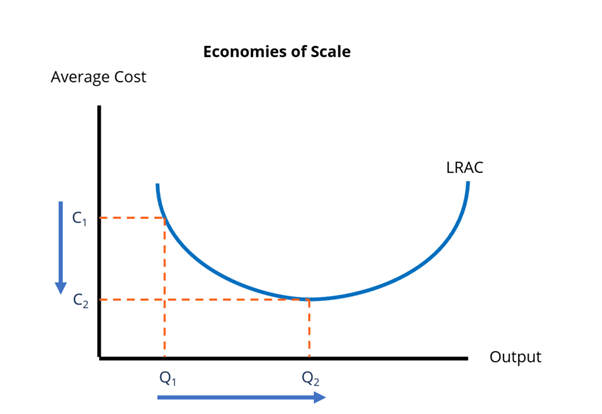
Image: CFI’s Financial Analysis Courses
The aforementioned graph shows how a firm’s long-run average costs (LRAC) compare to its level of output. The company’s average cost decreases from C1 to C2 as its output increases from Q1 to Q2. As a result, it may be argued that the company has scale economies up to output level Q2.
An important finding from the study of the production process in economics is that a corporation that seeks to maximize profits always strives to produce at the level that results in the lowest average cost per unit of output.

Internal vs. External Economies of Scale
There are two distinct kinds of economies of scale, as was already mentioned. Internal economics originate within the organization. On external elements, external ones are founded.
Internal economies of scale are exclusive to a given company since they result from internal cost reductions. This can be the outcome of the company’s size in general or of decisions made by the management of the organization. Because they can purchase materials in bulk, have a patent or unique technology, or have access to more cash, larger organizations may be able to achieve internal economies of scale—lowering their costs and raising their output levels.
On the other hand, external economies of scale are attained as a result of external causes or factors that have an impact on the entire sector. This implies that no corporation manages costs independently. These happen when there is a pool of highly skilled workers, when there are tax breaks or subsidies, when there are partnerships and joint ventures, or if there is anything else that can reduce costs for numerous businesses in a certain sector.
Types of internal economy of scale
The cost savings a company experiences as it expands and uses more sophisticated machinery and large-scale mechanical operations are known as technical economies. Technical economies are likely to occur in the case of a mass producer of motor vehicles since it can use mass production techniques and gain from specialization and the division of labor. Technical economies are more probable when procedures can be scaled up quickly.
When larger companies buy in bulk and receive discounts, purchasing economies are gained. In comparison to a local fruit and vegetable provider, a huge supermarket chain can purchase fresh fruit in far larger numbers.
When major businesses divide their administrative and managerial expenses among all of their facilities, offices, divisions, or subsidiaries, administrative savings might result. For instance, a sizable multinational can use a single team of financial accountants to handle all of its various operations.
Financial economies exist because big businesses can save money by borrowing money more affordably than small businesses. This is so that they can be perceived as smaller risks, especially as compared to young enterprises, and because they typically have more valuable assets that can be utilized as security (collateral). In reality, inadequate cash flow causes many new businesses to fail in the first few years.
Large companies often benefit from risk-bearing economies because they can handle business risks better than smaller companies. A large record label, for instance, is better able to handle the risk of a “flop” than a smaller record label.

Limits to Economies of Scale
Limits to economies of scale have been the focus of management approaches and technology for decades.
Lower setup costs are a result of more adaptable technology. Equipment costs are more closely matched to production capacity, making it easier for smaller companies like craft breweries and steel mini-mills to compete.
Costs become more comparable across companies of different sizes when functional services are outsourced. Accounting, human resources, marketing, treasury, law, and information technology are some of these functional services.
Set-up and production costs can be reduced by micromanufacturing, hyper-local manufacturing, and additive manufacturing (3D printing). Regardless of the size of a certain factory, global trade and logistics have helped to cut costs.
The International Monetary Fund reports that during the past three decades, prices for capital goods and the cost of machinery and equipment have decreased in emerging, developed, and even industrial nations.
Examples of Economies of Scale
In a hospital, a doctor visit still lasts for 20 minutes, but the hospital system’s administrative expenses are split among more doctor visits, and the person helping the doctor is no longer a licensed nurse but rather a technician or nursing assistant.
Groups of products, such shirts with your brand logo, are produced by job shops. The setup contributes significantly to the price. Larger production runs in job shops have lower unit costs because the setup expenditures of developing the logo and producing the silk-screen pattern are dispersed over a greater number of shirts. More seamless technology with robots in an assembly facility lowers per-unit expenses.
The limitations of economies of scale are frequently demonstrated in a restaurant kitchen where there are many chefs crammed into a tiny area. This has been depicted in economics charts as resembling a U-shaped curve, where the average cost per unit first decreases and then increases. It is known as “dis-economies of scale” when costs increase as production volume increases.
Sources of Economies of Scale
1. Purchasing
By purchasing the components needed for the production process in bulk or from certain wholesalers, businesses may be able to reduce average costs. The purchasing company utilizes economies of scale by haggling with suppliers for volume reductions.
2. Managerial
Companies may be able to reduce average expenses by strengthening their internal management structure. Managers with greater training or experience may be hired by the company.
3. Technological
The production process might be substantially altered by a technology improvement. For instance, a few years ago, fracking radically transformed the oil business. However, the new technology was only accessible to huge oil companies with the funds to purchase pricey fracking machinery.
Diseconomies of Scale
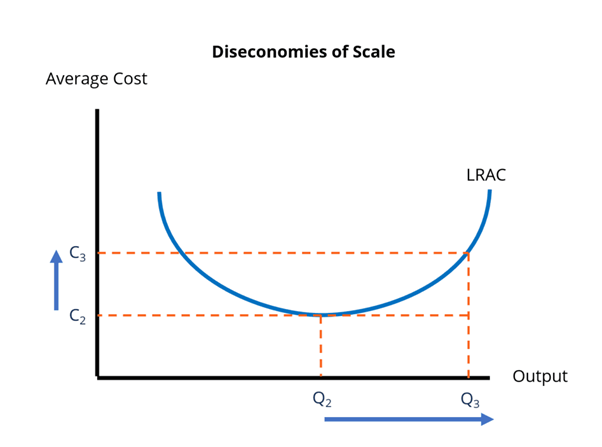
Image: CFI’s Financial Analysis Courses
Take a look at the graph above. Average expenses rise whenever output increases past Q2. This is an illustration of a diseconomy of scale, or an increase in average costs brought on by a larger size of manufacturing.
Firms get more complex as they expand in size. These businesses must strike a balance between scale economies and scale disadvantages. For instance, if a company boosted output, it might be able to apply some economies of scale in its marketing section. The management division of the company may have scale diseconomies as a result of growing output, though.
Distinguished management professor Frederick Herzberg offered the following justification for why businesses shouldn’t aim solely for economies of scale:
“Numbers numb our feelings for what is being counted and lead to adoration of the economies of scale. Passion is in feeling the quality of experience, not in trying to measure it.”

Protection from the Risk of Takeover
What Is a Hostile Takeover?
The acquisition of one business by another against the former’s desires is referred to as a “hostile takeover.” In a hostile takeover, the firm being acquired is referred to as the target company, and the party carrying out the acquisition is referred to as the acquirer. In a hostile takeover, the assailant goes straight to the company’s shareholders or fights to oust the management to secure shareholder approval for the acquisition. Typically, a tender offer or a proxy battle are used to approve a hostile takeover.
Understanding Hostile Takeovers
A hostile takeover from the acquisition side is frequently influenced by the same factors as any other takeover, such as the perception that a firm may be materially undervalued or a desire to get access to its operations, brand, technology, or market position. A hostile takeover may also be a calculated maneuver by activist investors seeking to alter a company’s business practices.
In a hostile takeover, the target company’s management disapproves of the agreement. When a party tries to take over a company without the support or cooperation of the target company’s board of directors, it makes this kind of bid. Instead of receiving board permission from the target company, the potential buyer could instead:
• Make a bid offer.
• Use a proxy battle
• Try to purchase the required company stock on the open market.
The board of directors has the right to reject a tender offer made by a corporation, investor, or group of investors to buy shares of another company at a price over the CMV. If the offer is made to the shareholders at a sufficient premium to market value or if they are dissatisfied with the current management, they may accept it. Tender offers are governed by the Williams Act of 1968, which also mandates the disclosure of all-cash tender offers.
In a proxy dispute, competing stockholder organizations convince other stockholders to use their shares’ proxy votes in their favor. A firm that makes a hostile takeover proposal may use the proxies it has obtained to vote in favor of the offer if it obtains a sufficient number.

Defending Against a Hostile Takeover
The management of the target company may have put preventative measures in place to thwart the unwelcome takeover or it may use reactive defenses to fight back.
Differential Voting Rights (DVRs)
A corporation can create stock with differential voting rights (DVRs), where some shares have more voting power than others, as a defense against hostile takeovers. If management owns a sizable enough percentage of shares with greater voting power, it may be harder to secure the votes required for a hostile takeover. Additionally, shares with fewer voting rights sometimes pay out bigger dividends, which can make them more desirable investments.
Employee Stock Ownership Program (ESOP)
A tax-qualified plan is used to create an employee stock ownership program (ESOP), in which employees hold a sizable stake in the business. Employees might vote more frequently in favor of management. As a result, this is a viable defense.
Such scams have, however, come under investigation in the past. Defensive ESOPs have occasionally been declared illegal by courts on the basis that management rather than shareholders were the intended beneficiaries of the plan.
Crown Jewel
In a crown jewel defense, a clause in the bylaws of the firm mandates the sale of its most valuable assets in the event of a hostile takeover, making the company less appealing as a target for an acquisition. This is frequently seen as the final line of defense.
Poison Pill
A shareholder rights plan is the official name for this defensive strategy. If one shareholder purchases more shares than a predetermined percentage, it enables existing shareholders to purchase freshly issued stock at a discount, diluting the acquiring company’s ownership stake. The discount does not apply to the buyer that initiated the defense, which is typically the acquiring business.
The phrase “poison pill” is frequently used in a wide sense to refer to a variety of defenses, including releasing more debt in an effort to make the target less desirable and giving staff stock options that vested upon a merger.
Other Strategies
A company’s management may occasionally employ a number of contentious tactics to ward off hostile takeover attempts, including the Pac-Man defense, the people poison pill, and golden parachute.
The golden parachute involves providing executive team members of the target with benefits (bonuses, severance pay, stock options, among others) if they are ever terminated as a result of a hostile takeover, whereas a people poison pill calls for the resignation of key personnel in the event of a hostile takeover. The Pac-Man defense entails the target firm buying stock in the target company aggressively.

Hostile Takeover Examples
An aggressive takeover can be a challenging and drawn-out process, and efforts frequently fail. For instance, in 2011, household goods major Clorox rejected each of the three acquisition bids made by billionaire activist investor Carl Icahn and responded by introducing a new shareholder rights plan. Even Icahn’s proxy fight efforts were thwarted by the Clorox board, and the takeover attempt failed after a few months.
The acquisition of Genzyme by the pharmaceutical company Sanofi (SNY) is an illustration of a successful hostile takeover. Sanofi regarded Genzyme as a way to enter a specialized market and diversify its product line because the firm made medications for the treatment of uncommon genetic illnesses. Sanofi went straight to the shareholders, paid a premium for the shares, attached contingent value rights, and ultimately succeeded in acquiring Genzyme after amicable takeover approaches were rejected by the company due to Sanofi’s efforts to get a controlling interest in it.
How Is a Hostile Takeover Done?
The tender offer, a proxy battle, and buying stock on the open market are all methods of taking control of another corporation. A majority of the shareholders must approve a tender offer for it to be accepted. The goal of a proxy battle is to remove the majority of the target’s unwilling board members. Another option for an acquirer is to just purchase enough company stock on the open market to gain control.
How Can Management Preempt a Hostile Takeover?
Establishing stocks with varying voting rights, such as creating a share class with less voting rights and a greater dividend, is one strategy to stop hostile takeovers. In particular, if management controls a sizable portion of the shares with more voting rights, these shares become an appealing investment, making it more difficult to obtain the votes required for a hostile takeover.
Companies may also implement a program for employee stock ownership. ESOPs give employees the opportunity to own a sizable portion of the business. This makes it a somewhat effective barrier against being purchased because it gives employees the opportunity to vote with management.
What Is a Poison Pill?
A common defense against a hostile takeover is a poison pill, which is officially referred to as a shareholder rights plan. The flip-in and flip-over are two different poison pill protection strategies. A flip-in allows current shareholders to purchase new stock at a reduced price if they amass a certain amount of target company shares. The purchasing company’s ownership interest is diminished and it is not included in the sale. If the acquisition goes through, a flip-over approach enables the target firm’s shareholders to purchase the acquiring company’s stock at a much reduced price, punishing the acquiring business by reducing its equity.

What Are Other Defenses to a Hostile Takeover?
Companies can protect themselves from hostile takeovers via the Pac-Man defense, golden parachute, and crown-jewel defense. A company’s bylaws mandating the sale of its most valuable assets in the case of a takeover is known as a “crown gem defense.” The company may become less appealing to potential buyers as a result. When a takeover is completed, a golden parachute offers the target’s senior executives significant advantages, which can deter other buyers. A Pac-Man defense entails the target business flipping the script and making quick acquisitions of the acquirer’s stock.
Difference Between Takeover and Acquisition
The two differ slightly from one another. The target companies may or may not be open to takeovers or buyouts. Acquisitions, on the other hand, are usually cordial.
The management of the target company may not participate with the buyer in a hostile takeover. The former management does not advise the new owners on internal matters or administration. In contrast, the management and board give acquisitions their full backing.

Course Manual 8: Share Risk Through Diversification
Diversifying and entering new markets
Businesses of all types must make a crucial decision regarding whether or not to diversify. Do you decide to stick to your strengths and focus solely on one task? Or do you try to take advantage of breaking into new markets by providing new goods and services? It’s crucial to take into account in the digital age, because clients’ preferences can shift abruptly and swiftly.
If a company chooses to diversify, it must be conscious of the necessity to concentrate on the new endeavor while maintaining its core business. By providing a wider selection of goods and services, they face the risk of distributing their resources too thinly.
There must therefore be balance in diversification. Although it seems simple in principle, reality can be very different. Fortunately, there are strategies for reducing the risk of diversification that can guide business owners in determining whether or not to launch a new product line.
What is diversification?
At its most basic level, product diversification is a business strategy used to boost profitability and increase sales volume from new items. It can happen at the corporate level or at the business level, which gives us the definitions that follow:
• Expanding into a new area of an industry in which the company already operates is known as business-level product diversification.
• Corporate-level product diversification is the process of entering a new market that is outside the company’s current sphere of expertise.
What are some diversification strategies?
There are four different types of strategies that companies might employ when trying to diversify. These are listed below:
Concentric diversification: When a company expands into comparable markets or goods, it creates synergy for the company. A laptop manufacturer expanding their product line is an illustration of this type of approach.
Horizontal diversification is the process through which a company enters a new industry, whether related or unrelated, while still in the same stage of development as its existing operations. For instance, Avon began by selling its goods through mail order before expanding to retail establishments. This is still in the retail phase of the production process despite the change.
Vertical diversification is the process through which a business returns to an earlier or alternatively, a later stage of its manufacturing cycle. For instance, a business that specializes in home reconstruction starts selling paint and building supplies.
Conglomerate diversification is the process through which a company expands into a field that is entirely unrelated to its existing operation. Entering a new market with a fresh consumer base is regarded as the riskiest method because it results in higher R&D and advertising costs.

Benefits of diversification?
A rise in sales and income.
The boost in sales and revenue that a new market can offer is one of the most alluring advantages of diversification. This is especially helpful if a company dominates a certain market but is having trouble increasing profitability and gaining new clients. An opportunity for expansion may arise with the introduction of a new good or service.
lowered susceptibility
If a small business depends on one or two big customers for their income, losing one of these customers puts them in a precarious situation. Diversification can offer a chance to lessen the pain of losing a crucial customer because it has the ability to tap into a bigger consumer base, even without considerable development.
It equalizes the risks.
The goal of diversification is to spread your risk so that if one of your investments loses value, the others won’t necessarily do the same. This is done by diversifying your business’ investments. Your risks are better balanced as a result.
Simply put, you risk losing all of your money if you put all of your money on one product and it fails. However, even if you simply invested 20% of your money in that product, you would still have 80% of it available for use.
What are some diversification best practices?
Recognize your market.
Do as much research as you can. Learn about your possible competitors, new distribution channels, and the skills you’ll need to develop your product and launch it on the market. Additionally, keep timing in mind; if your market is struggling, perhaps now isn’t the best moment to launch a new product.
Don’t undersell your abilities.
Let’s say you’ve attracted some attention and a potential customer wants to hire you. You quote the lowest price on the spur of the moment since you’re eager to convince them to join you. Here is where market research is crucial; if you provide a potential customer a price that is significantly lower than the industry standard, you’ve already made a poor first impression. Consider your new rivals and position yourself so that you may demand a greater price when the time comes to transact business.
Be astute when forming financial alliances.
Be aware that most lending terms are created to favor investors if you’re looking for funds to diversify your investments. Make sure you understand what you’re offering them compared to what they’re giving to you in return before you establish communication channels.
Before allocating funds to a diversification project, you might want to think about some of the alternative funding choices listed below.
Know your limitations.
If you’re considering starting a diversification process, think about the resources you have at your disposal as well as the financial resources you have to invest. You must consider both the initial capital required to start diversification as well as the ongoing capital needed to maintain growth, hire additional staff, and pay their salaries.
By being aware of your constraints, you may determine how much effort you’re willing to put into the diversification process and what needs to be done.
Know the industry you are entering well.
Do you have the teams and systems in place to put the essential processes in place once you’ve decided how you want to diversify? Are you able to provide them in a way that is consistent with your prior methods and with the competence for which you have been known?
On the other hand, your company does not want to be in a situation where it must play catch-up. Keep up with all market and competition developments and stay one step ahead of the game. With this “early adopter” strategy, you’ll be ready for any changes or trends in the industry.
Verify that the procedure adds value.
Your brand name appearing on new products or in uncharted markets may raise questions in the minds of your current customers or cause confusion. A crucial area to concentrate on is making sure the new services continue to add value for the customer. It will help to reinforce and increase the feasibility of these areas you are diversifying into if your service or product can provide your clients something they can use frequently.
Maybe you can change your existing offering to appeal to a different user base. Could you offer a more reasonably priced version if your offering is a “high-end” good or service?
Move both vertically and horizontally.
Finding the opportunities that diversity offers your company is a crucial step in the decision-making process. Think about your current location and the possible horizontal and vertical movements.
Consider how much more you can do what you’re doing now in terms of vertical diversification. What can you do in your region to improve and give your customers even more value? Is there a method to improve and streamline your current product or service so that you can advance and draw in a new clientele?
Consider what your competitors are doing that you might not be doing while thinking horizontally. Are there any relevant business prospects or sectors that are similar to the one or the niche that you are working in? Consider what works for your company and how you might make these additional areas useful for your clients.

Diversification matrixes: How do they differ?
Ansoff Matrix
The Ansoff Matrix, also known as the Product/Market Expansion Grid, illustrates four growth strategies: Market Development, Market Penetration, Product Development, and Diversification. According to the theory, the risk increases every time you enter a new quadrant, either horizontally or vertically.
The riskiest of the four alternatives, diversification is located in the upper right quadrant of the matrix. Why? It’s risky since it demands a business to produce a new product, target new, uncharted markets, and apply a variety of techniques. A corporation must honestly examine the risks and have a clear understanding of the benefits it anticipates from diversity before deciding to implement it. However, this kind of strategy can be quite effective if risk and reward are balanced properly.

Boston Matrix
To distribute investments among a company’s product portfolio, the Boston Matrix can be used to analyze the portfolio. The Boston Matrix classifies products into one of four categories based on market share and growth:
1. Stars: High-growth items that compete in markets and outperform their rivals on a comparative basis; they require significant investment to maintain growth. Stars will turn into cash cows as the growth slows down and they maintain their market share.
2. Cash cows: Products having a high market share and low growth rates that require less investment because they are already established and successful. However, they must be managed to maintain a profit so that they can keep producing the robust cash flows required by the business for Stars.
3. Question Marks: Products with low market share that are active in industries that are experiencing rapid expansion may have potential but also require significant effort to gain market share at the expense of rivals. Managers must decide which ones to invest in and which ones to let fail, as their name implies.
4. Dogs: Products with low market share and slow growth that may just make enough money to break even but are rarely worthwhile investments. typically shuttered or sold as a result.

This approach aids firms in making crucial decisions, and its usage of market share serves as a reliable indicator of a product’s capacity for profit. However, it merely provides a snapshot of a company’s current state and has minimal forecasting power as a result.
Like all diversification initiatives, risk and reward must be balanced, yet doing so can be essential to real success and company expansion.

Course Manual 9: Attract Customers
Importance of attracting new customers through growth
No matter how much potential your current clientele still has, I firmly believe that every business needs new customers. According to the law of entropy, you cannot advance while standing still because every peak you reach will eventually disappear. We must therefore advance rather than simply remain stationary. You need be extremely focused on your marketing knowledge, branding, channels, content, and lead generation operations to attract new clients as a result of this alone.
Here are some more explanations for why acquiring new consumers is crucial:
1. Getting new clients creates energy. They give your organization a distinct vibrancy. A “feel good” effect is brought on by a consistent influx of new, high-quality customers. Good employees prefer to work for expanding, prosperous companies, and bringing on new clients is a wonderful KPI by which team members unconsciously gauge a company’s success.
2. They provide you with a reason to celebrate. Each office at PANALITIX has a bell mounted on the wall. Every time a sale is made, the bell gets rung. There is a wonderful buzz in the air when the bell rings, and everyone cheers. People are interested in the new client’s identity and some background information. Public congratulations are extended to the individual who introduced the new client. Additionally, every bell is a definite sign that we are moving closer to our objectives because the number of clients we service is the crucial figure in our strategic plan.
3. New clients (of the right kind) bring new needs and challenges. This alone compels you to pick up and use fresh skills. Of course, rather than waiting for the client to call, you should be actively seeking out those prospects.
4. New clients demand fresh approaches. You can grow weary of working with the same clientele year after year. A fresh perspective can inspire you and your team to seriously consider concepts you can present to the new client to pleasure them and assist them in realizing their objectives. You may then use those concepts to brainstorm with your team about potential applications for additional clients, which is a side benefit.
5. Lifts customer service. Funny how team members step up their communication while speaking with new clients. Although it’s wrong in and of itself, it appears to me that you need to bring your “A game” when dealing with new clients, whereas with current ones, things can sometimes be lax. Take note of the service improvements that result from dealing with new clients, keep the bar high, then formalize your suggestions as performance guidelines that can be applied to ALL of your clientele.
6. A new client presents a chance for a second new client. A fresh potential referral source is created by new clients. When you sign a new customer, you should let them know in advance that, presuming they are happy with the work you have done, you will be asking them for the names of two business owners who could use your services in six months.
7. A fresh perspective on references. I genuinely hope you have a lot of client testimonials describing the advantages of working with your company. What about requesting a testimonial from recent clientele describing their decision to work with your company? There must be a reason why they selected you. Take advantage of it and use it in your marketing.
8. Every new customer is a chance to expand your clientele. Only “A” class clients or, at the very least, clients that have the potential to swiftly become “A” class clients, should you be accepting new clients. The quality of your clientele will often increase gradually if you stick to this maxim with each new client you take on. By using this additional tactic, you may go one step further. Each time you take on a new client for business, get rid of two or three clients who you know you shouldn’t be working with.
9. New customers are clean slates. You can present novel ideas without worrying about the client’s possible reactions. Although I have to admit that this is frequently used as a justification for avoiding implementing techniques like upfront price and payment with existing clients, I always hear that it is much simpler to implement them with new clients. You can adjust the rules when you have new customers. similar to defining the requirements for becoming a client of your firm. Creating a client waiting list is another option.
10. Establish a minimal level of service. I think you should hold an annual goal-setting session with all new clients as a matter of course, meet with them in person at least twice a year, hold an annual general meeting with them (that goes beyond the compliance requirements), have a live budget and cash flow forecast, and keep track of their financial information on a monthly basis. You establish the guidelines for new clients (and then transition those rules to existing clients gradually.)

5 Reasons Why Customer Retention Is Key to Your Business
Customer retention means satisfying existing customers so they continue buying from your brand instead of competitors. It takes eight purchases for a customer to be considered a “regular” at a company, but customer retention is about much more than repeat orders.
So why is customer retention important?
Optimizing the customer experience and listening to their needs leads to lifetime brand loyalty, plus major financial benefits. On average, attracting a new customer costs five times as much as keeping an existing one, plus up to 30 times the marketing cost. However, increasing customer retention rates by just 5% can boost your profits by 25% to 95%!
Here are five reasons why customer retention is important for your ROI:
1. Lower Marketing Costs
2. Repeat Purchases Means Repeat Profit
3. Word-of-Mouth Advertising
4. Gain Valuable Feedback
5. Sell at Premium Prices
1. Lower Marketing Costs
Your marketing budget goes further by prioritizing existing customers in the retention stage of the buyer journey. Repeat buyers are already familiar with your products and services, so marketing campaigns for loyal customers don’t need to be as expensive. According to BCG, advertising to an existing customer costs about $7, whereas it costs around $34 for a new client一that’s over four times as much! Existing customers also have keen brand awareness, lowering their reliance on customer support that saves you money, depending on your industry.
2. Repeat Purchases Means Repeat Profit
Loyal customers who make regular purchases tend to spend up to 33% more money when they do, resulting in higher customer lifetime value. They’re also 50% more likely to try new products than new customers due to mutual trust with your brand. A valued customer not only believes that your products are superior to competitors in the market, but that your company aligns with their needs and preferences. To satisfy existing customers, take note of their buying history and recommend related products to encourage future purchases.
3. Free Word-Of-Mouth Advertising
You’ve probably heard it before, but it’s worth repeating: word-of-mouth is the most cost-effective form of advertising. And guess what? It only comes from loyal customers who believe in your brand.
Repeat customers are more likely to share their positive experiences with like-minded people, essentially becoming free advocates for your business. This tactic works because people trust the opinions of those who are close to them. Almost half of U.S. consumers say that their friends and family are their top sources of brand awareness, and 92% of people trust recommendations from their friends and family over any other type of marketing.

4. Gain Valuable Feedback
Part of winning over customers is providing an exceptional customer experience, which requires listening. In past surveys, 97% of consumers said they are somewhat likely to become more loyal to a company that implements their feedback, while 55% of consumers said they’re not likely to continue being a customer of a company that ignores their feedback.
Customers who make frequent purchases from your business will also see areas of improvement, so don’t be afraid to ask. Gathering feedback can be as easy as sending an email to your subscriber list, putting up a poll on your social media accounts, or sending surveys to clients right after they place an order. Once you implement new changes, you’ll find opportunities that were overlooked, as well as increase retention rates and sales.
5. Previous Customers Will Pay Premium Prices
Repeat buyers are far less price-conscious than new leads because they’ve used your products before. This is especially true among millennials who would only switch brands if prices were at least 10% lower. About 70% of the younger age group also pays premium prices when perks (like free shipping) are offered in loyalty programs. Overall, many customers associate higher prices with quality service, so offering added benefits motivates them to keep coming back.

Course Manual 10: Expand Products or Services
Benefits of a product line extension
Expanding a firm’s product range through product line extension is a very common strategic decision. Along with product improvements, product line extensions form the majority of new product launches for established firms.
What is a product line extension?
Any new product introduced to the market that belongs to the same product category as those that the company already produces and offers is considered a product line extension. A product category is a group of products that are related to one another, such as dairy products, computer products, furniture, cars, and so forth.
We frequently observe product line extensions in supermarkets and convenience stores. Typically, they are alterations to an already-existing brand’s product. Examples include adding another Mountain Dew flavor or changing a Kellogg’s cereal. Although Kellogg’s already produces and promotes cereal, bringing a new kind to market would still be considered extending their product line and would be categorized as such.

Advantages of a product line extension
• Established and loyal customer base
• Existing expertise
• Retailer relationships
• Low cost of production
• Low cost of development
• Provides market information
• Competitive barriers
• Easy to implement
• Possible economies of scale
• Supply relationships
• Meets variety needs of consumers
Established and loyal customer base
By offering a different version of an established brand, a corporation can capitalize on the popularity and existing brand loyalty. This increases overall customer equity and client lifetime value while also making immediate sales and profit far more possible.
Existing expertise
By concentrating on the range of products that they already produce and market a company can be reassured that it has the existing expertise within the company to be successful of a product line extension.
Retailer relationships
The company is likely to have established wholesaler and retailer distribution networks in place, staying within the same product category and just expanding the product portfolio. This indicates that there shouldn’t be a need for overly aggressive trade advertisements and that the new product should become widely available pretty rapidly.
Low cost of production
As a company has existing expertise and processes in place for this category of product, then it is likely that their production costs will be relatively low – as the new product will be produced utilizing the existing systems of the company.
Low cost of development
Because the company has developed this category product before, there should be a relatively low-cost development – primarily because they have the in-house expertise and knowledge, along with the necessary IT/manufacturing capabilities.
Provides market information
The company can offer a variety of marketing mix offerings for one of these brands/products at a time and is able to gather useful market intelligence by using the other brands/products as a control by having a range of related items (within the same product category). As a result, the business may do more marketing experiments and gather deeper customer insights.
Competitive barriers
By having a broader range of products within the same product category, makes it more difficult for competitors to find an obvious gap in the marketplace. It would also have the impact of fragmenting the market and splitting segments into niches. This may have the effect of making it non-viable for a competitor to bring a similar product to the market.
Easy to implement
Having produced a marketed this type of product before, it is highly likely that the new product development process and marketing launch will be quite simple the company to implement. They should be able to do this easily with existing personnel and probably without the need to outsource to consultants or other specialists.
Possible economies of scale
With a broader product range, and hopefully a greater level of sales volume, it may be possible to achieve improved economies of scale – and create a lower cost structure and a higher profit unit margin.
Supply relationships
Supplier relationships should be enhanced because the firm is likely to purchase more materials from the existing suppliers because they are manufacturing and/or producing a similar product or service.
Meets variety needs of consumers
Product line extension should also meet in with a variety needs of customers, say in a food market where variety is important – or meet the needs of a different market segment.

The benefits of expanding your product range?
Let’s look at a few reasons why top retailers are adding new products to their offerings to drive growth.
Improving customer loyalty
Developing loyal customers is a key strategy for sales growth as it’s usually more cost-effective than new customer acquisition.
Product line expansion means you can give your customers more options. If they can find everything they need on your sales channels, they won’t have to go to your competitor’s sites/stores.
It also comes back to convenience and ease. Customers appreciate having everything in one place, so you’ll be improving the overall customer experience. Cater to these demands to sell more products, ensure repeat business and build stronger, long-lasting relationships with your existing customers.
Increasing Average Order Values (AOV)
Higher AOV (Average Order Value) is a common KPI in the world of eCommerce. When a customer is browsing your products, you want to maximize the value of that visit. Looking to increase your AOV is a cheap and easy way of doing that. Product bundles and kits are key here. You can display relevant and associated products to the one your customer is looking at by creating product relationships. The more products you have on offer, the more scope you have to create kits and bundles.
By creating more kits and bundles, you increase the range of products that are already selling well. Providing this extra layer of choice to your customers will likely encourage them to add more to their baskets. You can take an informative approach when displaying product relationships. Consider your wording to make sure they feel like they’re being advised of the other complementary products on offer.
Increasing profit margins with long-tail products
Making the most of long tailing is becoming simpler with the growing popularity of techniques like dropshipping. Here, you can sell less quantities of difficult-to-find goods while earning higher profit margins.
Your catalog will get a competitive edge and improve your online positioning if you include these specialty products. Customers will value the ability to locate products that are difficult to discover. By providing these specialized goods, you can distinguish yourself from the competition. You’ll probably see more sales as well as better customer loyalty.
Long tailing is a fantastic way to generate significant cash benefits, especially if you choose the drop shipping method. It means that for the smallest possible investment, you can enhance your sales by offering upselling chances.
Reducing costs by dropshipping digital products
Many of the dangers and difficulties associated with traditional eCommerce and distribution are removed by dropshipping. You’ve made investments in your brand, and your consumer base is expanding and devoted. By dropshipping from your dependable supply chain, you may improve the experience you provide for your clients and increase your revenue.
By using dropshipping, you may sell the products of your suppliers and have them send them right to your clients. This means that it avoids passing through your warehouse, which results in significant cost savings on pricey real estate and logistics. Which products from your suppliers go on your sales channels is entirely up to you. The assets can then be improved using your PIM to match your brand’s style and voice.
Only after a customer places an online order will the product be added to your ERP via your PIM. Because of this, your integrated systems won’t be impeded until absolutely necessary.
Increasing your customer base
You can extend your target market and increase your consumer base by adding more products to your range of offerings. At this point, you might want to think about offering many product variations at a range of price points. This minimizes the possibility of losing clients due to pricing choices.
By doing this, you can target a wide range of demographics and meet the specific requirements of your clients. Your brand’s reach will grow if you sell goods at various price points, which will also make purchasing more accessible.
Increase the likelihood of upselling by delivering superior products with ease. Retailers who develop budget or plus size lines, for instance, are also serving a bigger target market.
Gill Marine is an outstanding illustration of this. In the US, fishing is quite well-liked, thus Gill Marine was eager to take advantage of this. With the help of Pimberly, it was able to create an internal eCommerce site, saving the business a ton of money. The first order was being processed by Gill Fishing in less than a month after the project began!

Course Manual 11: Attract Top Talent
Why is talent important?
Superior talent is up to eight times more productive.
It’s amazing how much great talent can boost an organization’s productivity. High performers are 400 percent more productive than mediocre performers, according to a recent survey of more than 600,000 researchers, artists, politicians, and athletes. Studies of firms demonstrate not only comparable outcomes, but also that the disparity widens as a job’s complexity increases. High performers are astonishingly 800% more productive in extremely complicated occupations, such as the information- and interaction-intensive work of managers, software developers, and the like (Exhibit 1).
Exhibit 1

Business performance and talent quality have a strong correlation.
Let’s say your business strategy calls for three years to finish a number of cross-functional projects. How quickly might the intended impact be achieved if 20% of the average talent working on the project was replaced with excellent skill? It would take less than two years if these individuals were 400 percent more productive, and it would take less than one if they were 800 percent more prolific. Even if it started a year or two later, a competitor may outperform you in the market if it employed 20% more excellent talent in comparable initiatives.
You find much more astounding results comparing the output of the top and bottom 1 percent. The top 1% produce three times as much for unskilled and semiskilled positions as the bottom 99% do, and twelve times as much for jobs of moderate complexity (such as technicians and supervisors). 12 people in the bottom one percent are equal to one person in the top one percent. The difference for high-complexity jobs is too great to quantify.
Go after the top of the crop, as the late Apple CEO Steve Jobs advised, to best express the value of talent. A small group of A+ players can outperform a large group of B and C players. Jim Collins, a management expert, agreed: “The capacity to acquire and keep enough of the proper people is the single biggest restraint on the performance of my firm.”

Top 5 Reasons Why Hiring the Right Employee is Essential
Most successful organisations believe that employees are one of the most valuable assets of a business. The right employee will contribute to the overall success of the company. However, hiring the right employee isn’t easy, and hiring the wrong person can be detrimental to your business.
1) Productivity
More or less, every employee adds to the productivity of your organisation. Hiring the right people can contribute to the overall growth of your company and can also lessen the need for you to hire more employees. Remember, great employees are an investment that will pay off in the future. They will align their goals with the organisation’s and understand that their success directly correlates to the organisations.
2) Saves Time and Money
We are aware that hiring is not simple. Background checks, job board advertisements, interviews, skill assessments, etc. cost money. Hiring managers will devote significant time to responding to each applicant, reviewing resumes, and doing interviews. Similar to this, when you have hired your new employee, you will invest time and money in training them and acquainting them with your company’s procedures and culture. Therefore, choosing the proper candidate will prevent you from having to pay additional expenses down the road if they turn out to be the wrong kind of worker.
3) Ripple Effect
Employees can either positively or negatively induce their workmates. The right employee will create a long-lasting impact on not only your organisation but the people around them. Use a specialist recruitment agency to find the right person who will positively impact, motivate, and work with other employees. Hiring the right employee will create synergy and will lead to the growth and productivity of your organisation.
4) Reputation
When you hire an employee, there are numerous risks involved. The reputation of your business being damaged is one of the more serious risks. In today’s digital environment, the majority of businesses grant employees access to systems, confidential data, and passwords so they can carry out their jobs. This information can be misused and leaked to rivals or the public by a reliable source. Integrity is a quality of the ideal candidate.
5) Customer Satisfaction
You might be thinking, ‘how can hiring the right employee lead to customer satisfaction?’. Excellent employees appreciate both their coworkers and the clients they serve. The ideal candidate will possess superior customer service abilities that will draw in new clients and keep existing ones. According to studies, the main factor that causes customers to discontinue doing business with a firm is a bad customer experience.
Recruiting capable workers is a terrific strategy to raise your business’s prospects of expansion and success. However, the truth is considerably more complicated than that.
The greatest of the best should always be recruited while attempting to recruit new talent. With a low unemployment rate and fierce rivalry for workers, it is sometimes necessary for us to develop new methods and procedures in order to attract top talent. This can take a lot of time, but it will be well worth it in the end.
You’ll not only draw in workers with boundless potential, but you’ll also help them develop their skills to the fullest. Your long-term investment in your staff is probably going to pay out in several different ways.

Benefits of attracting the top talent to your company
The benefits that come along with incorporating these strategies help create an environment that will allow your employees to function at their best.
Here are just a few of the perks you’re likely to enjoy.
1. People are more productive when they’re happy
Workers of today seek a better work-life balance. Including tactics like flexible work schedules might initially seem a little weird, but it undoubtedly has its benefits.
Researchers tested the relationship between worker output and their reported levels of satisfaction in 2015. The evaluation’s findings demonstrated that production and employee satisfaction were highly correlated.
Offering this choice can support a more wholesome, stress-free work atmosphere, whether employees choose to work remotely a few times per week because they prefer it, or they simply want to spend more time with their friends and family.
2. Your company can generate more money
In a recent study, the validity of this idea was further investigated using employee reviews from well-known websites. Researchers discovered a significant association between company performance and employee satisfaction.
The findings showed that businesses with more profitability typically have employees who report higher levels of job satisfaction.
The final word? Personnel are worthwhile. They’re more likely to perform better when we give them the best chance of succeeding and see them as assets.
3. You’ll gain a competitive edge
Offering continued education and mentorship is a huge draw for motivated employees who are often lifelong learners. As a plus, it also keeps your employees engaged, learning and up to date with industry standards.
Not only will you attract highly qualified employees who are eager to learn more and stay ahead of the game, you’ll also allow them to incorporate what they’re learning into your business to make it better.
4. Combat employee turnover and increase retention
A fantastic method to make sure your staff stick around for the long run is to develop a clear mission statement and include other strategies to recruit and invest in their development. You can be sure you’re hiring people whose values coincide with your own when your values and goals are crystal clear.
Additionally, today’s workers want to believe that they are employed by a company that values and supports the issues that are significant to them. Employee satisfaction and contentment are more likely to increase when that occurs.
New hire onboarding is expensive and time-consuming. Long term, investing the time to take the onboarding process seriously is a fantastic way to be proactive about employee retention and preventing turnover.
5. Build a team of people who care about your company and want it to succeed
Your staff will be more inclined to value you in return if you take the time to listen to them and invest in them. By making an investment in their ongoing success, you may help them feel appreciated and happier while also bringing out their best qualities.
You start to open doors for your business that are likely to take you to bigger and better places when you start to see your personnel as assets rather than just as labor. In the end, one of the most important aspects of managing a successful, lucrative business is attracting the appropriate people and putting them in a position for success.

Course Manual 12: Greater Sustainability
Growth is required for Sustainability – To sustain means to remain active in a given field for an extended period of time. A firm must be sustainable in order to expand, and it cannot grow without being sustainable. The business environment is constantly changing, thus it is best for a company to adapt to this change and seize opportunities to ensure its sustainability.
The global community has moved past the “going green” cliché and recognizes that sustainability is more than just a trend. Sustainability is a comprehensive, long-term strategy for managing hazards, including social and financial as well as environmental. The three bottom lines of a sustainable company are profit, planet, and people.
More businesses are starting to recognize the advantages of sustainability. According to Eco-Officiency, a consulting company that aids businesses in creating and implementing sustainability plans, “being a ‘green’ organization can enhance a company’s image and develop strong brand loyalty among customers and other stakeholders.” But it can also result in fewer operating expenses and better revenues.
Eco-Officiency put together a list of five big benefits of being a sustainable business. We’ve added that list below:
1) Enhanced Brand and Increased Competitive Advantageb
The National Marketing Institute reports that 58% of American consumers are likely to purchase goods and services from businesses that are conscious of their influence on society and the environment. According to the NMI, these customers are prepared to pay up to 20% extra for goods and services that are ecologically friendly.
2) Increased Productivity and Reduced Costs
Developing sustainable business practices will streamline operations, making a company more efficient, and conserve resources, decreasing a company’s operational costs.
3) Improve Financial and Investment Opportunity
According to Goldman Sachs study, companies in six industries that are considered leaders in environmental sustainability have outperformed the general stock market by 25%.
4) Minimize Carbon Risk and Improve Energy Efficiency
The reduction of carbon emissions by businesses is anticipated to be 25% by 2020 and 50% to 80% by 2050, as required by both state and federal rules. The cost and availability of electricity will be impacted by this. Companies and firms promise to maintain their sustainability initiatives despite threats to environmental laws. According to BizJournals.com, WEC Energy Group declared in May that it has already cut its carbon dioxide emissions by 26% since 2000 and that it intends to cut them even more. According to a July Wall Street Journal article, a number of American corporations, including Apple Inc., Google Inc., Microsoft Corp., and Bank of America Corp., would invest at least $140 billion in new projects to reduce their carbon footprints and boost support for renewable energy.
5) Increase Employee Retention and Recruitment
Employees want to work with companies who are proactive with corporate environmental and social programs. By offering sustainable practices, companies can recruit and retain a greater talent pool.

The Importance of Environmental Awareness When Running a Business
Many individuals are becoming more and more concerned about sustainability, particularly in the corporate sphere. Our lives and the fate of all other creatures on the earth are still being impacted by climate change. Sustainable business practices are quickly becoming essential for company owners, managers, and administrators. NASA estimates that the likelihood of human activities contributing to the planet’s warming is greater than 95%. Because of its reliance on land, resources, fossil fuels, and continuous production and consumption, human industry contributes significantly to climate change.
Understanding the problem at hand and how crucial it is to make changes — for the business and the planet — is the first step in making firms more sustainable. The goal of this resource is to assist business owners, managers, and executives in increasing environmental awareness inside their firms. A working definition of sustainability in business, an explanation of its significance, a list of the important stakeholders, a discussion of the advantages and difficulties, and details on how to enhance sustainability in business are all provided here.
Sustainability in Business: What Does It Mean?
The concept of conducting business without having a negative influence on the environment is known as sustainability in business. A green business supports the community and economy that depend on a healthy earth by acting in the local and global environment’s best interests. An environmentally conscious company thinks about its impact on society and the environment in addition to its financial performance. Such a business is sustainable because it helps maintain the integrity of the building in which it works, creating a setting in which the business may flourish.
A sustainable company follows the triple bottom line, a concept that was first introduced in 1994 by John Elkington, the creator of the British consultancy SustainAbility. Profits, people, and the environment are the triple bottom line’s three pillars. By conserving our use of the planet’s resources and being socially responsible, a sustainable business makes money.
Why Is Sustainability Important in Business?
The “Great Pacific Garbage Patch” serves as an example of how crucial it is for corporations to place a high priority on sustainability. The Pacific Ocean is home to a floating island of plastic that is about 1.6 million square kilometers in size, or about twice the size of Texas, according to the scientific journal Environmental Sustainability. Microplastics from this plastic can be found in seafood and affect marine life as well as humans. If it weren’t for businesses who utilize it to make and package goods, this plastic would not exist.
Simply put, many species won’t live through the 21st century if corporations don’t behave responsibly as members of the global community. “The human-caused rate of extinction of species of both plants and animals at present is hundreds of times higher than the natural rate in the past,” Environmental Sustainability writes.
According to Environmental Sustainability, the business environment that stresses quick production and turnover of products for maximum profits has put us on track to produce 27 billion tons of solid garbage by 2050. By 2050, it is predicted that unchecked CO2 emissions will lead to a two-degree Celsius rise in global temperature, which will raise sea levels and increase the frequency of catastrophic weather events.
According to a study, only 100 corporations are accountable for 71% of the world’s emissions. Now is the perfect time for businesses to join the effort, reduce emissions and waste, and help create a planet that is habitable. The good news is that, in accordance with the Paris Climate Accord, corporations may have a significant impact and be responsible for 60% of emissions reductions by 2030.

Sustainable Business Statistics
The following statistics illustrate where the business world is when it comes to sustainability:
Consumer Perception
• According to Cone Communications’ corporate social responsibility study, 63% of Americans want corporations to drive social and environmental change in the absence of government action.
• 87% of American consumers will make a purchase because a company advocated for an issue they care about.
• 76% of Americans expect companies to take action against climate change.
• 73% of Americans would stop purchasing from a company that doesn’t care about climate change.
Business Perception
• According to the 2018 BSR/Globescan survey of business leaders in charge of sustainability and corporate social responsibility, respondents identified ethics and integrity as the No. 1 reason for pursuing business sustainability.
• 75% of corporate sustainability professionals say that businesses need to get better at including sustainability into business strategy to address global mega-trends.
• 64% of North American respondents said sustainability needs to influence core business activities such as strategy and value creation; 84% of European respondents and 89% of respondents everywhere else agreed.
• Less than 33% of respondents said their businesses are actually engaging with sustainable strategic planning.
Business Impact
• According to a report from The New Climate Economy, 95% of plastic packaging — the equivalent of $120 billion annually — is wasted after the first use, and microplastics have been found in 114 aquatic species.
• Over 140 million people will be displaced from their homes by 2050 if business continues as usual.
• Industries must drop carbon emissions by 40% by 2060 to stop the planet from warming over two degrees Celsius.
• In combination with action from governments and other stakeholders, businesses that take action on climate change by adopting green policies, technologies, and strategies for growth could realize a total of $26 trillion in economic benefits.
The case for sustainability is strong. To become sustainable, your business must engage everyone who can contribute.
Workshop Exercises

Why Grow? Exercises
01. Survival: Explain in your own words how this process will directly impact upon your department?
02. Increase Sales: Explain in your own words how this process will directly impact upon your department?
03. Increase in Market Share: Explain in your own words how this process will directly impact upon your department?
04. Greater Power to Control the Market: Explain in your own words how this process will directly impact upon your department?
05. Increase Profits: Explain in your own words how this process will directly impact upon your department?
06. Economies of Scale: Explain in your own words how this process will directly impact upon your department?
07. Protection from the Risk of Takeover: Explain in your own words how this process will directly impact upon your department?
08. Shares Risk through Diversification: Explain in your own words how this process will directly impact upon your department?
09. Attract Customers: Explain in your own words how this process will directly impact upon your department?
10. Expand Products & Services: Explain in your own words how this process will directly impact upon your department?
11. Attract Top Talent: Explain in your own words how this process will directly impact upon your department?
12. Greater Sustainability: Explain in your own words how this process will directly impact upon your department?

SWOT & MOST Analysis Exercises
01. Undertake a detailed SWOT Analysis in order to identify your department’s internal strengths and weaknesses and external opportunities and threats in relation to each of the 12 Why Grow? processes featured above. Undertake this task together with your department’s stakeholders in order to encourage collaborative evaluation.
02. Develop a detailed MOST Analysis in order to establish your department’s: Mission; Objectives; Strategies and Tasks in relation to Why Grow?. Undertake this task together with all of your department’s stakeholders in order to encourage collaborative evaluation.
Project Studies
Project Study (Part 1) – Customer Service
The Head of this Department is to provide a detailed report relating to the Why Grow? process that has been implemented within their department, together with all key stakeholders, as a result of conducting this workshop, incorporating process: planning; development; implementation; management; and review. Your process should feature the following 12 parts:
01. Survival
02. Increase Sales
03. Increase Market Share
04. Greater Power to Control the Market
05. Increase Profits
06. Economies of Scale
07. Protection from the Risk of Takeover
08. Share Risk Through Diversification
09. Attract Customers
10. Expand Products & Services
11. Attract Top Talent
12. Greater Sustainability
Please include the results of the initial evaluation and assessment.
Project Study (Part 2) – E-Business
The Head of this Department is to provide a detailed report relating to the Why Grow? process that has been implemented within their department, together with all key stakeholders, as a result of conducting this workshop, incorporating process: planning; development; implementation; management; and review. Your process should feature the following 12 parts:
01. Survival
02. Increase Sales
03. Increase Market Share
04. Greater Power to Control the Market
05. Increase Profits
06. Economies of Scale
07. Protection from the Risk of Takeover
08. Share Risk Through Diversification
09. Attract Customers
10. Expand Products & Services
11. Attract Top Talent
12. Greater Sustainability
Please include the results of the initial evaluation and assessment.
Project Study (Part 3) – Finance
The Head of this Department is to provide a detailed report relating to the Why Grow? process that has been implemented within their department, together with all key stakeholders, as a result of conducting this workshop, incorporating process: planning; development; implementation; management; and review. Your process should feature the following 12 parts:
01. Survival
02. Increase Sales
03. Increase Market Share
04. Greater Power to Control the Market
05. Increase Profits
06. Economies of Scale
07. Protection from the Risk of Takeover
08. Share Risk Through Diversification
09. Attract Customers
10. Expand Products & Services
11. Attract Top Talent
12. Greater Sustainability
Please include the results of the initial evaluation and assessment.
Project Study (Part 4) – Globalization
The Head of this Department is to provide a detailed report relating to the Why Grow? process that has been implemented within their department, together with all key stakeholders, as a result of conducting this workshop, incorporating process: planning; development; implementation; management; and review. Your process should feature the following 12 parts:
01. Survival
02. Increase Sales
03. Increase Market Share
04. Greater Power to Control the Market
05. Increase Profits
06. Economies of Scale
07. Protection from the Risk of Takeover
08. Share Risk Through Diversification
09. Attract Customers
10. Expand Products & Services
11. Attract Top Talent
12. Greater Sustainability
Please include the results of the initial evaluation and assessment.
Project Study (Part 5) – Human Resources
The Head of this Department is to provide a detailed report relating to the Why Grow? process that has been implemented within their department, together with all key stakeholders, as a result of conducting this workshop, incorporating process: planning; development; implementation; management; and review. Your process should feature the following 12 parts:
01. Survival
02. Increase Sales
03. Increase Market Share
04. Greater Power to Control the Market
05. Increase Profits
06. Economies of Scale
07. Protection from the Risk of Takeover
08. Share Risk Through Diversification
09. Attract Customers
10. Expand Products & Services
11. Attract Top Talent
12. Greater Sustainability
Please include the results of the initial evaluation and assessment.
Project Study (Part 6) – Information Technology
The Head of this Department is to provide a detailed report relating to the Why Grow? process that has been implemented within their department, together with all key stakeholders, as a result of conducting this workshop, incorporating process: planning; development; implementation; management; and review. Your process should feature the following 12 parts:
01. Survival
02. Increase Sales
03. Increase Market Share
04. Greater Power to Control the Market
05. Increase Profits
06. Economies of Scale
07. Protection from the Risk of Takeover
08. Share Risk Through Diversification
09. Attract Customers
10. Expand Products & Services
11. Attract Top Talent
12. Greater Sustainability
Please include the results of the initial evaluation and assessment.
Project Study (Part 7) – Legal
The Head of this Department is to provide a detailed report relating to the Why Grow? process that has been implemented within their department, together with all key stakeholders, as a result of conducting this workshop, incorporating process: planning; development; implementation; management; and review. Your process should feature the following 12 parts:
01. Survival
02. Increase Sales
03. Increase Market Share
04. Greater Power to Control the Market
05. Increase Profits
06. Economies of Scale
07. Protection from the Risk of Takeover
08. Share Risk Through Diversification
09. Attract Customers
10. Expand Products & Services
11. Attract Top Talent
12. Greater Sustainability
Please include the results of the initial evaluation and assessment.
Project Study (Part 8) – Management
The Head of this Department is to provide a detailed report relating to the Why Grow? process that has been implemented within their department, together with all key stakeholders, as a result of conducting this workshop, incorporating process: planning; development; implementation; management; and review. Your process should feature the following 12 parts:
01. Survival
02. Increase Sales
03. Increase Market Share
04. Greater Power to Control the Market
05. Increase Profits
06. Economies of Scale
07. Protection from the Risk of Takeover
08. Share Risk Through Diversification
09. Attract Customers
10. Expand Products & Services
11. Attract Top Talent
12. Greater Sustainability
Please include the results of the initial evaluation and assessment.

Project Study (Part 9) – Marketing
The Head of this Department is to provide a detailed report relating to the Why Grow? process that has been implemented within their department, together with all key stakeholders, as a result of conducting this workshop, incorporating process: planning; development; implementation; management; and review. Your process should feature the following 12 parts:
01. Survival
02. Increase Sales
03. Increase Market Share
04. Greater Power to Control the Market
05. Increase Profits
06. Economies of Scale
07. Protection from the Risk of Takeover
08. Share Risk Through Diversification
09. Attract Customers
10. Expand Products & Services
11. Attract Top Talent
12. Greater Sustainability
Please include the results of the initial evaluation and assessment.

Project Study (Part 10) – Production
The Head of this Department is to provide a detailed report relating to the Why Grow? process that has been implemented within their department, together with all key stakeholders, as a result of conducting this workshop, incorporating process: planning; development; implementation; management; and review. Your process should feature the following 12 parts:
01. Survival
02. Increase Sales
03. Increase Market Share
04. Greater Power to Control the Market
05. Increase Profits
06. Economies of Scale
07. Protection from the Risk of Takeover
08. Share Risk Through Diversification
09. Attract Customers
10. Expand Products & Services
11. Attract Top Talent
12. Greater Sustainability
Please include the results of the initial evaluation and assessment.

Project Study (Part 11) – Logistics
The Head of this Department is to provide a detailed report relating to the Why Grow? process that has been implemented within their department, together with all key stakeholders, as a result of conducting this workshop, incorporating process: planning; development; implementation; management; and review. Your process should feature the following 12 parts:
01. Survival
02. Increase Sales
03. Increase Market Share
04. Greater Power to Control the Market
05. Increase Profits
06. Economies of Scale
07. Protection from the Risk of Takeover
08. Share Risk Through Diversification
09. Attract Customers
10. Expand Products & Services
11. Attract Top Talent
12. Greater Sustainability
Please include the results of the initial evaluation and assessment.

Project Study (Part 12) – Education
The Head of this Department is to provide a detailed report relating to the Why Grow? process that has been implemented within their department, together with all key stakeholders, as a result of conducting this workshop, incorporating process: planning; development; implementation; management; and review. Your process should feature the following 12 parts:
01. Survival
02. Increase Sales
03. Increase Market Share
04. Greater Power to Control the Market
05. Increase Profits
06. Economies of Scale
07. Protection from the Risk of Takeover
08. Share Risk Through Diversification
09. Attract Customers
10. Expand Products & Services
11. Attract Top Talent
12. Greater Sustainability
Please include the results of the initial evaluation and assessment.
Program Benefits
Marketing
- Sales models
- Business growth
- Business strategy
- Customer loyalty
- Enhanced performance
- Improved responsiveness
- Opportunity analysis
- Supplier evaluation
- Corporate goals
- Market analysis
Management
- Engaged workforce
- Increased trust
- Heightened teamwork
- Productive meetings
- Idea generation
- Increased revenue
- Role clarity
- Role distinctions
- Tasking formula
- Effective communication
Finance
- Cost-effective
- Return on investment
- Budget friendly
- Financially sustainable
- Profitability enhancement
- Self-financing
- Performance improvement
- Cost savings
- Controlled growth
- Calculated risk
Client Telephone Conference (CTC)
If you have any questions or if you would like to arrange a Client Telephone Conference (CTC) to discuss this particular Unique Consulting Service Proposition (UCSP) in more detail, please CLICK HERE.

























